Company Valuation Report
VerifiedAdded on 2023/06/04
|24
|6076
|484
AI Summary
This report provides insights on the current valuation of Bega Cheese Limited in the market, its performance compared to competitors, intrinsic value estimation, and relative valuation techniques. It also includes an industry analysis and SWOT analysis.
Contribute Materials
Your contribution can guide someone’s learning journey. Share your
documents today.
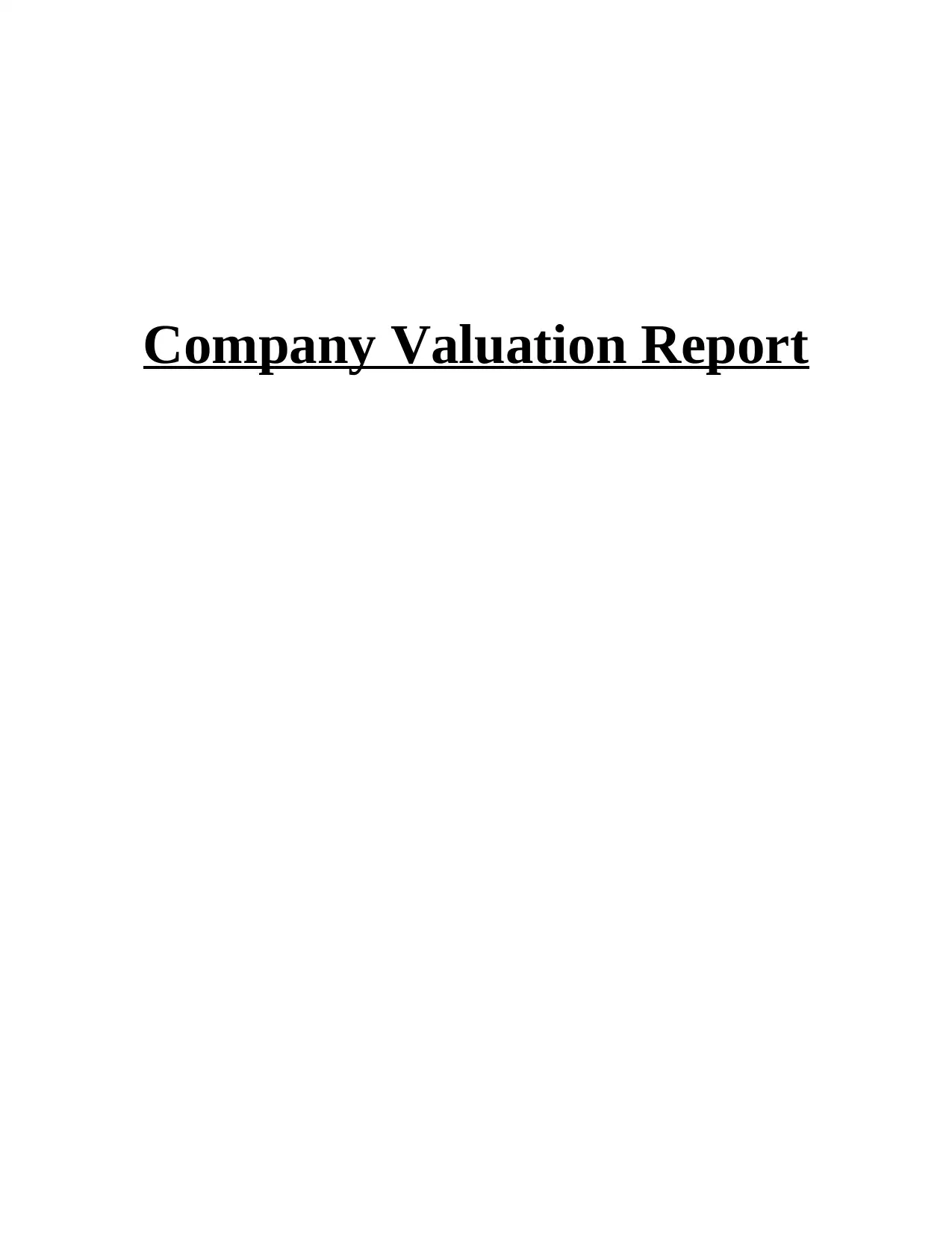
Company Valuation Report
Secure Best Marks with AI Grader
Need help grading? Try our AI Grader for instant feedback on your assignments.
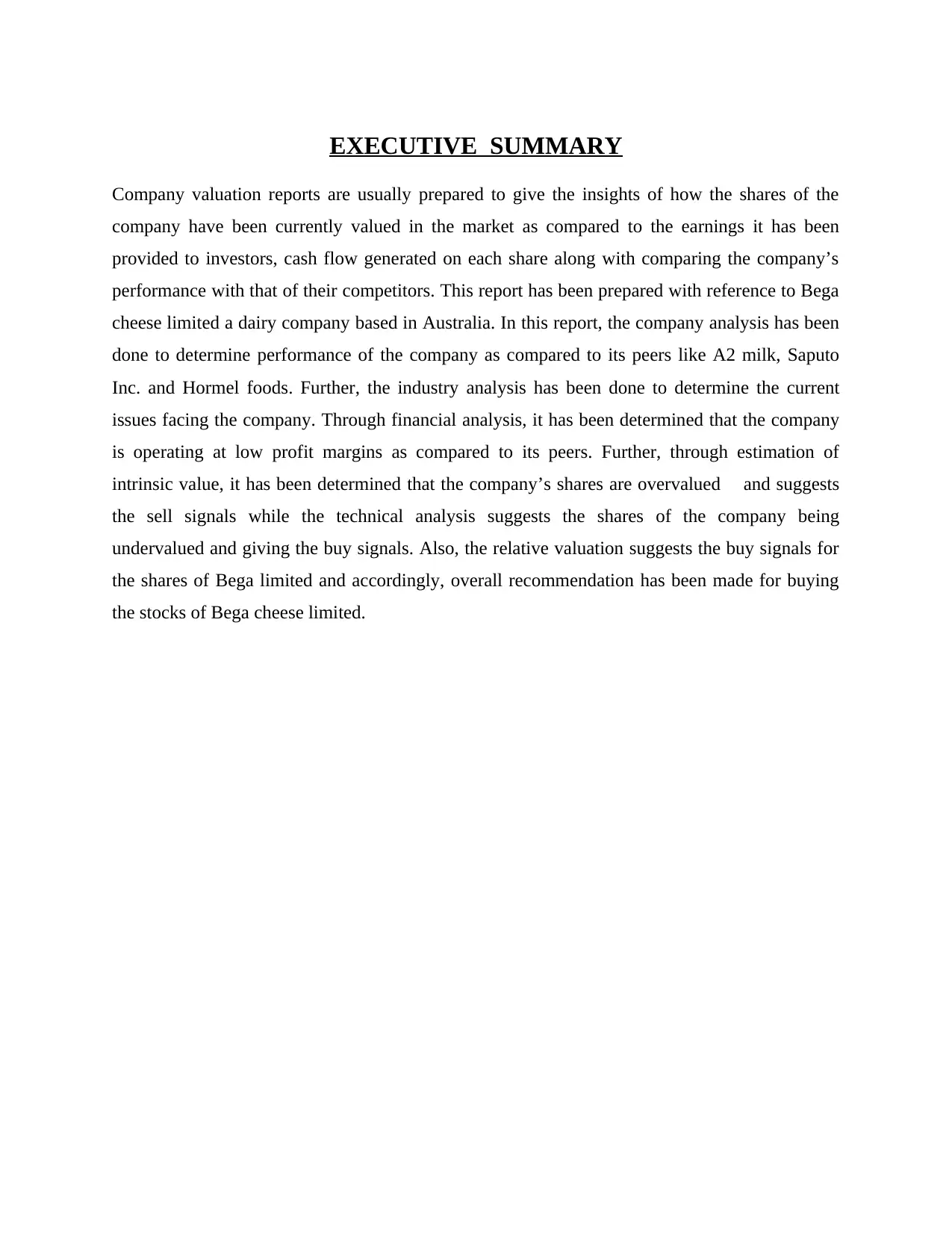
EXECUTIVE SUMMARY
Company valuation reports are usually prepared to give the insights of how the shares of the
company have been currently valued in the market as compared to the earnings it has been
provided to investors, cash flow generated on each share along with comparing the company’s
performance with that of their competitors. This report has been prepared with reference to Bega
cheese limited a dairy company based in Australia. In this report, the company analysis has been
done to determine performance of the company as compared to its peers like A2 milk, Saputo
Inc. and Hormel foods. Further, the industry analysis has been done to determine the current
issues facing the company. Through financial analysis, it has been determined that the company
is operating at low profit margins as compared to its peers. Further, through estimation of
intrinsic value, it has been determined that the company’s shares are overvalued and suggests
the sell signals while the technical analysis suggests the shares of the company being
undervalued and giving the buy signals. Also, the relative valuation suggests the buy signals for
the shares of Bega limited and accordingly, overall recommendation has been made for buying
the stocks of Bega cheese limited.
Company valuation reports are usually prepared to give the insights of how the shares of the
company have been currently valued in the market as compared to the earnings it has been
provided to investors, cash flow generated on each share along with comparing the company’s
performance with that of their competitors. This report has been prepared with reference to Bega
cheese limited a dairy company based in Australia. In this report, the company analysis has been
done to determine performance of the company as compared to its peers like A2 milk, Saputo
Inc. and Hormel foods. Further, the industry analysis has been done to determine the current
issues facing the company. Through financial analysis, it has been determined that the company
is operating at low profit margins as compared to its peers. Further, through estimation of
intrinsic value, it has been determined that the company’s shares are overvalued and suggests
the sell signals while the technical analysis suggests the shares of the company being
undervalued and giving the buy signals. Also, the relative valuation suggests the buy signals for
the shares of Bega limited and accordingly, overall recommendation has been made for buying
the stocks of Bega cheese limited.
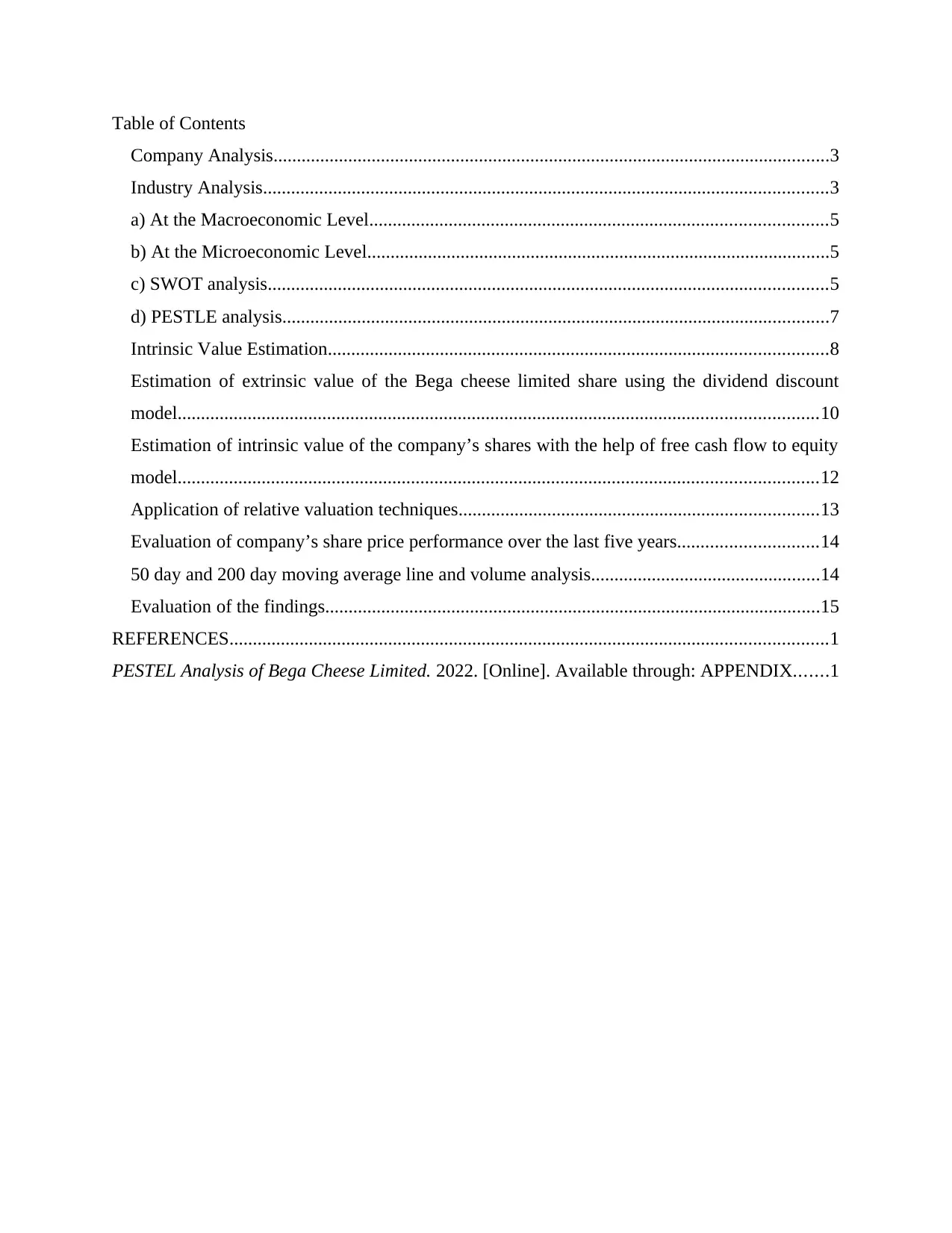
Table of Contents
Company Analysis.......................................................................................................................3
Industry Analysis.........................................................................................................................3
a) At the Macroeconomic Level..................................................................................................5
b) At the Microeconomic Level...................................................................................................5
c) SWOT analysis........................................................................................................................5
d) PESTLE analysis.....................................................................................................................7
Intrinsic Value Estimation...........................................................................................................8
Estimation of extrinsic value of the Bega cheese limited share using the dividend discount
model.........................................................................................................................................10
Estimation of intrinsic value of the company’s shares with the help of free cash flow to equity
model.........................................................................................................................................12
Application of relative valuation techniques.............................................................................13
Evaluation of company’s share price performance over the last five years..............................14
50 day and 200 day moving average line and volume analysis.................................................14
Evaluation of the findings..........................................................................................................15
REFERENCES................................................................................................................................1
PESTEL Analysis of Bega Cheese Limited. 2022. [Online]. Available through: APPENDIX.......1
Company Analysis.......................................................................................................................3
Industry Analysis.........................................................................................................................3
a) At the Macroeconomic Level..................................................................................................5
b) At the Microeconomic Level...................................................................................................5
c) SWOT analysis........................................................................................................................5
d) PESTLE analysis.....................................................................................................................7
Intrinsic Value Estimation...........................................................................................................8
Estimation of extrinsic value of the Bega cheese limited share using the dividend discount
model.........................................................................................................................................10
Estimation of intrinsic value of the company’s shares with the help of free cash flow to equity
model.........................................................................................................................................12
Application of relative valuation techniques.............................................................................13
Evaluation of company’s share price performance over the last five years..............................14
50 day and 200 day moving average line and volume analysis.................................................14
Evaluation of the findings..........................................................................................................15
REFERENCES................................................................................................................................1
PESTEL Analysis of Bega Cheese Limited. 2022. [Online]. Available through: APPENDIX.......1
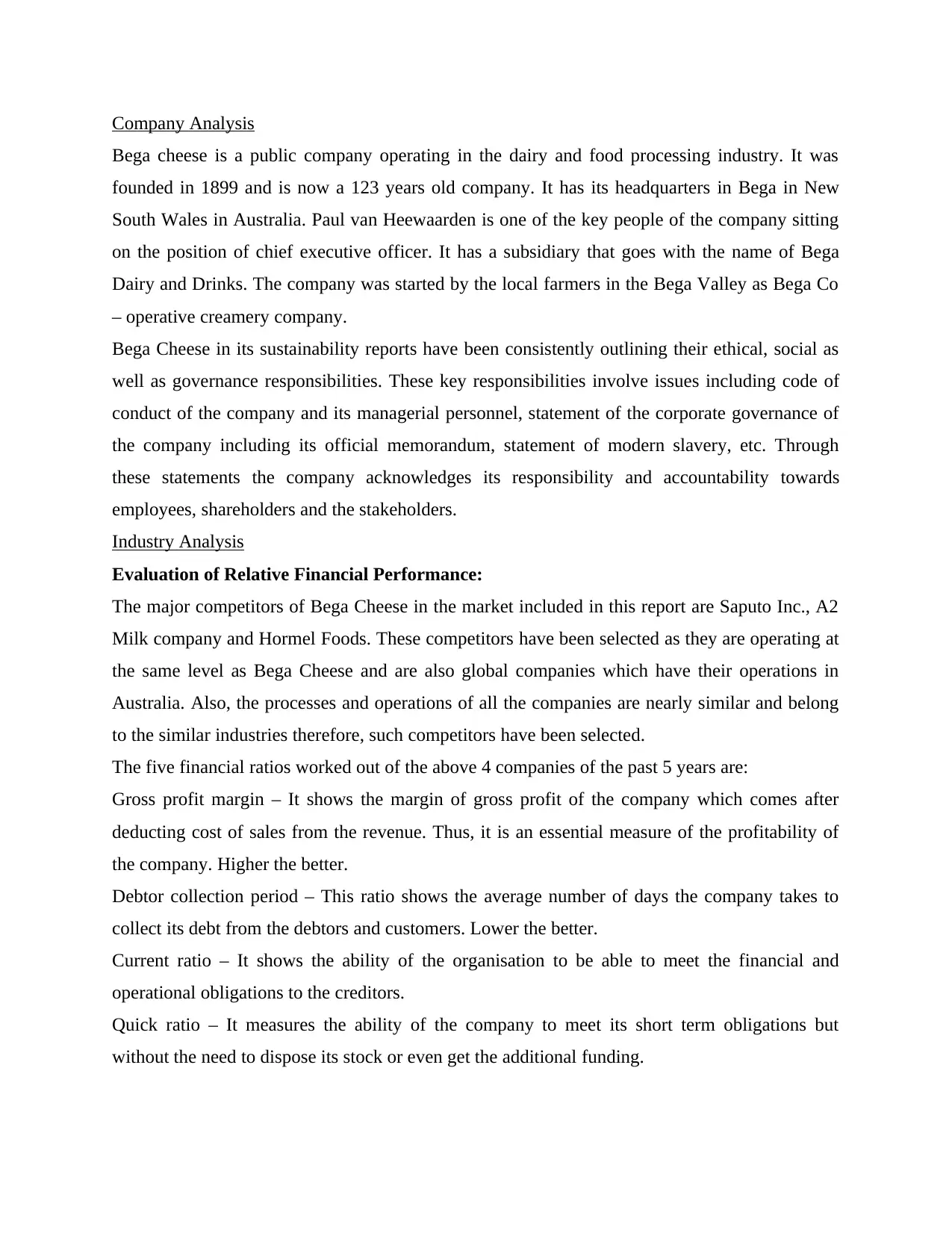
Company Analysis
Bega cheese is a public company operating in the dairy and food processing industry. It was
founded in 1899 and is now a 123 years old company. It has its headquarters in Bega in New
South Wales in Australia. Paul van Heewaarden is one of the key people of the company sitting
on the position of chief executive officer. It has a subsidiary that goes with the name of Bega
Dairy and Drinks. The company was started by the local farmers in the Bega Valley as Bega Co
– operative creamery company.
Bega Cheese in its sustainability reports have been consistently outlining their ethical, social as
well as governance responsibilities. These key responsibilities involve issues including code of
conduct of the company and its managerial personnel, statement of the corporate governance of
the company including its official memorandum, statement of modern slavery, etc. Through
these statements the company acknowledges its responsibility and accountability towards
employees, shareholders and the stakeholders.
Industry Analysis
Evaluation of Relative Financial Performance:
The major competitors of Bega Cheese in the market included in this report are Saputo Inc., A2
Milk company and Hormel Foods. These competitors have been selected as they are operating at
the same level as Bega Cheese and are also global companies which have their operations in
Australia. Also, the processes and operations of all the companies are nearly similar and belong
to the similar industries therefore, such competitors have been selected.
The five financial ratios worked out of the above 4 companies of the past 5 years are:
Gross profit margin – It shows the margin of gross profit of the company which comes after
deducting cost of sales from the revenue. Thus, it is an essential measure of the profitability of
the company. Higher the better.
Debtor collection period – This ratio shows the average number of days the company takes to
collect its debt from the debtors and customers. Lower the better.
Current ratio – It shows the ability of the organisation to be able to meet the financial and
operational obligations to the creditors.
Quick ratio – It measures the ability of the company to meet its short term obligations but
without the need to dispose its stock or even get the additional funding.
Bega cheese is a public company operating in the dairy and food processing industry. It was
founded in 1899 and is now a 123 years old company. It has its headquarters in Bega in New
South Wales in Australia. Paul van Heewaarden is one of the key people of the company sitting
on the position of chief executive officer. It has a subsidiary that goes with the name of Bega
Dairy and Drinks. The company was started by the local farmers in the Bega Valley as Bega Co
– operative creamery company.
Bega Cheese in its sustainability reports have been consistently outlining their ethical, social as
well as governance responsibilities. These key responsibilities involve issues including code of
conduct of the company and its managerial personnel, statement of the corporate governance of
the company including its official memorandum, statement of modern slavery, etc. Through
these statements the company acknowledges its responsibility and accountability towards
employees, shareholders and the stakeholders.
Industry Analysis
Evaluation of Relative Financial Performance:
The major competitors of Bega Cheese in the market included in this report are Saputo Inc., A2
Milk company and Hormel Foods. These competitors have been selected as they are operating at
the same level as Bega Cheese and are also global companies which have their operations in
Australia. Also, the processes and operations of all the companies are nearly similar and belong
to the similar industries therefore, such competitors have been selected.
The five financial ratios worked out of the above 4 companies of the past 5 years are:
Gross profit margin – It shows the margin of gross profit of the company which comes after
deducting cost of sales from the revenue. Thus, it is an essential measure of the profitability of
the company. Higher the better.
Debtor collection period – This ratio shows the average number of days the company takes to
collect its debt from the debtors and customers. Lower the better.
Current ratio – It shows the ability of the organisation to be able to meet the financial and
operational obligations to the creditors.
Quick ratio – It measures the ability of the company to meet its short term obligations but
without the need to dispose its stock or even get the additional funding.
Secure Best Marks with AI Grader
Need help grading? Try our AI Grader for instant feedback on your assignments.
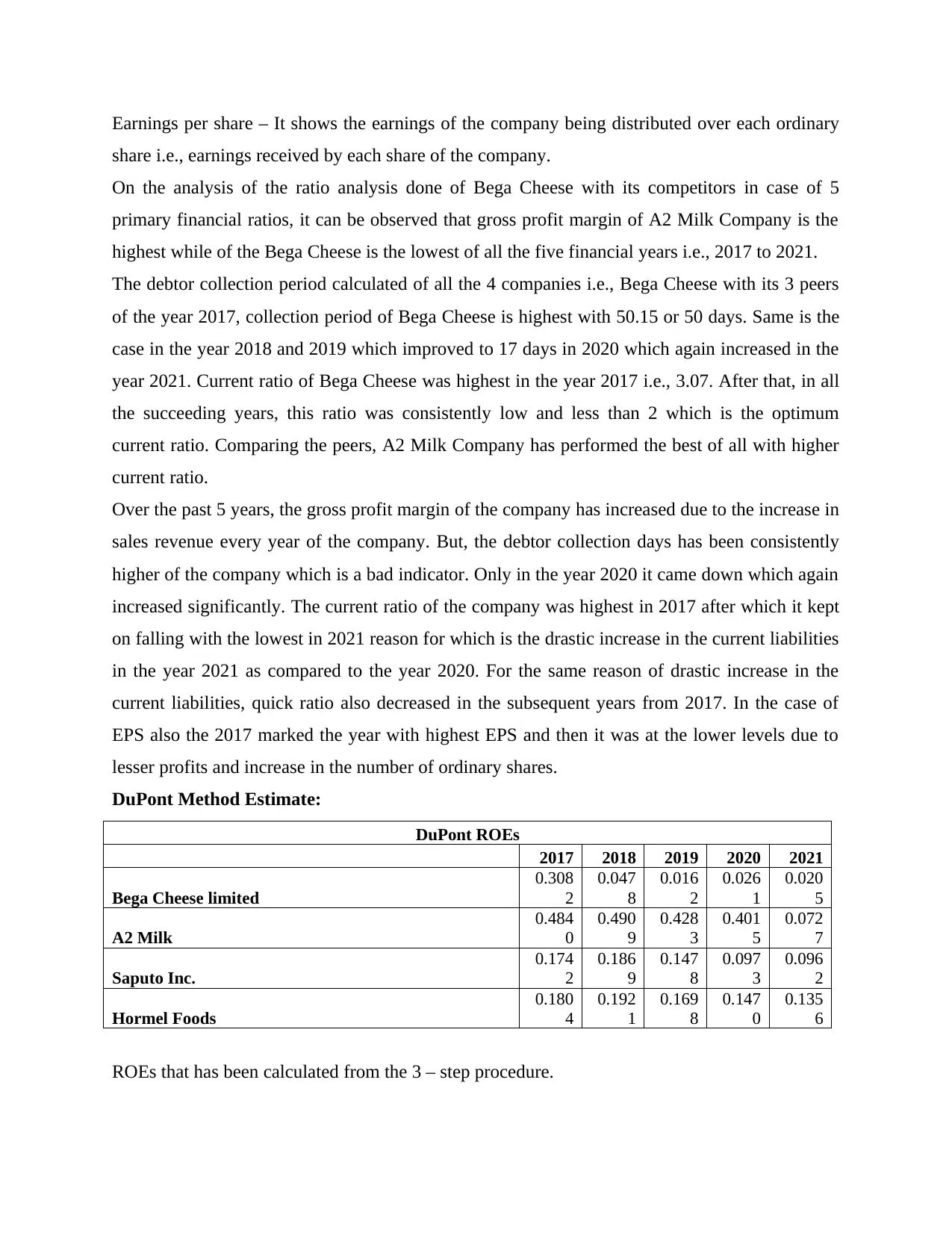
Earnings per share – It shows the earnings of the company being distributed over each ordinary
share i.e., earnings received by each share of the company.
On the analysis of the ratio analysis done of Bega Cheese with its competitors in case of 5
primary financial ratios, it can be observed that gross profit margin of A2 Milk Company is the
highest while of the Bega Cheese is the lowest of all the five financial years i.e., 2017 to 2021.
The debtor collection period calculated of all the 4 companies i.e., Bega Cheese with its 3 peers
of the year 2017, collection period of Bega Cheese is highest with 50.15 or 50 days. Same is the
case in the year 2018 and 2019 which improved to 17 days in 2020 which again increased in the
year 2021. Current ratio of Bega Cheese was highest in the year 2017 i.e., 3.07. After that, in all
the succeeding years, this ratio was consistently low and less than 2 which is the optimum
current ratio. Comparing the peers, A2 Milk Company has performed the best of all with higher
current ratio.
Over the past 5 years, the gross profit margin of the company has increased due to the increase in
sales revenue every year of the company. But, the debtor collection days has been consistently
higher of the company which is a bad indicator. Only in the year 2020 it came down which again
increased significantly. The current ratio of the company was highest in 2017 after which it kept
on falling with the lowest in 2021 reason for which is the drastic increase in the current liabilities
in the year 2021 as compared to the year 2020. For the same reason of drastic increase in the
current liabilities, quick ratio also decreased in the subsequent years from 2017. In the case of
EPS also the 2017 marked the year with highest EPS and then it was at the lower levels due to
lesser profits and increase in the number of ordinary shares.
DuPont Method Estimate:
DuPont ROEs
2017 2018 2019 2020 2021
Bega Cheese limited
0.308
2
0.047
8
0.016
2
0.026
1
0.020
5
A2 Milk
0.484
0
0.490
9
0.428
3
0.401
5
0.072
7
Saputo Inc.
0.174
2
0.186
9
0.147
8
0.097
3
0.096
2
Hormel Foods
0.180
4
0.192
1
0.169
8
0.147
0
0.135
6
ROEs that has been calculated from the 3 – step procedure.
share i.e., earnings received by each share of the company.
On the analysis of the ratio analysis done of Bega Cheese with its competitors in case of 5
primary financial ratios, it can be observed that gross profit margin of A2 Milk Company is the
highest while of the Bega Cheese is the lowest of all the five financial years i.e., 2017 to 2021.
The debtor collection period calculated of all the 4 companies i.e., Bega Cheese with its 3 peers
of the year 2017, collection period of Bega Cheese is highest with 50.15 or 50 days. Same is the
case in the year 2018 and 2019 which improved to 17 days in 2020 which again increased in the
year 2021. Current ratio of Bega Cheese was highest in the year 2017 i.e., 3.07. After that, in all
the succeeding years, this ratio was consistently low and less than 2 which is the optimum
current ratio. Comparing the peers, A2 Milk Company has performed the best of all with higher
current ratio.
Over the past 5 years, the gross profit margin of the company has increased due to the increase in
sales revenue every year of the company. But, the debtor collection days has been consistently
higher of the company which is a bad indicator. Only in the year 2020 it came down which again
increased significantly. The current ratio of the company was highest in 2017 after which it kept
on falling with the lowest in 2021 reason for which is the drastic increase in the current liabilities
in the year 2021 as compared to the year 2020. For the same reason of drastic increase in the
current liabilities, quick ratio also decreased in the subsequent years from 2017. In the case of
EPS also the 2017 marked the year with highest EPS and then it was at the lower levels due to
lesser profits and increase in the number of ordinary shares.
DuPont Method Estimate:
DuPont ROEs
2017 2018 2019 2020 2021
Bega Cheese limited
0.308
2
0.047
8
0.016
2
0.026
1
0.020
5
A2 Milk
0.484
0
0.490
9
0.428
3
0.401
5
0.072
7
Saputo Inc.
0.174
2
0.186
9
0.147
8
0.097
3
0.096
2
Hormel Foods
0.180
4
0.192
1
0.169
8
0.147
0
0.135
6
ROEs that has been calculated from the 3 – step procedure.
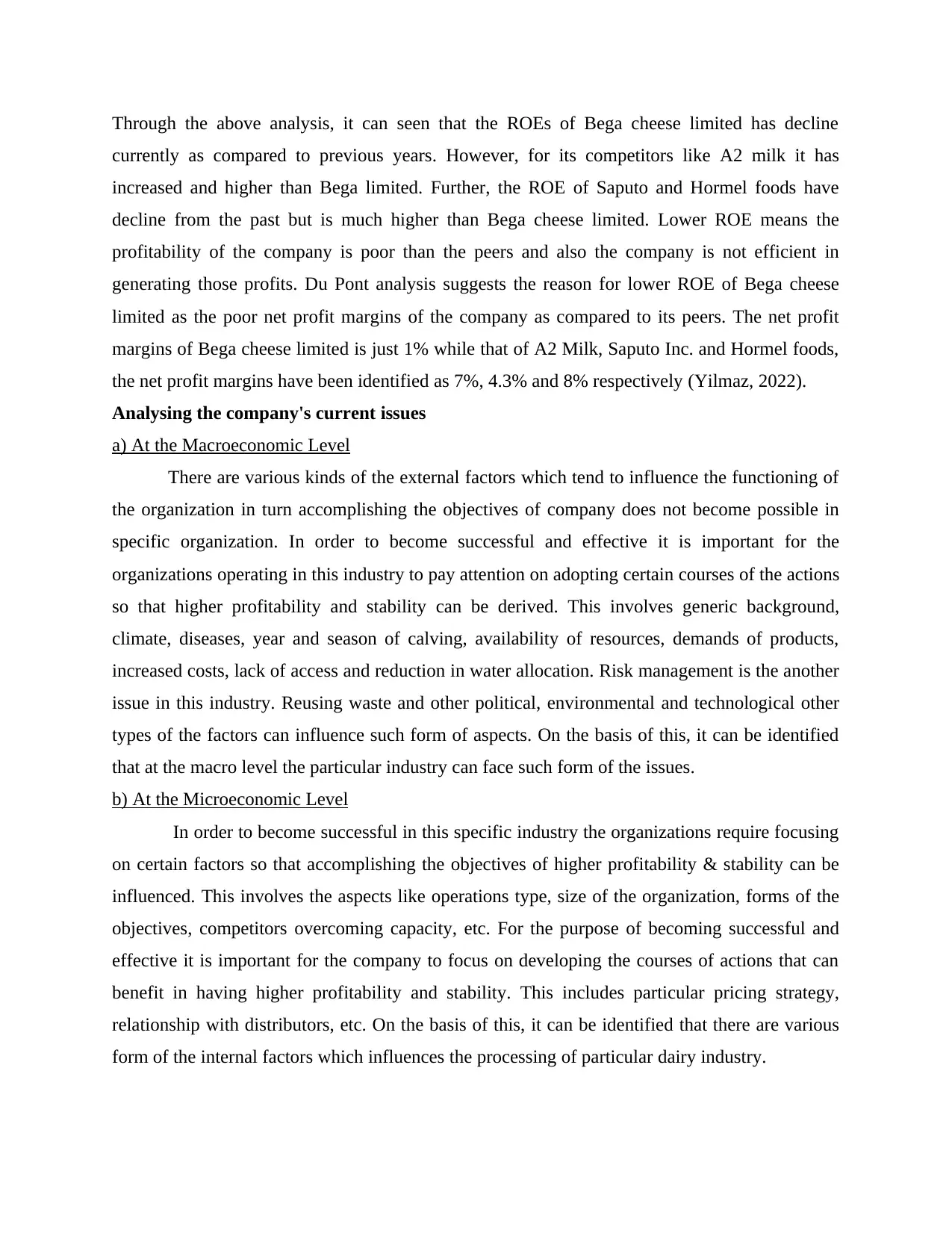
Through the above analysis, it can seen that the ROEs of Bega cheese limited has decline
currently as compared to previous years. However, for its competitors like A2 milk it has
increased and higher than Bega limited. Further, the ROE of Saputo and Hormel foods have
decline from the past but is much higher than Bega cheese limited. Lower ROE means the
profitability of the company is poor than the peers and also the company is not efficient in
generating those profits. Du Pont analysis suggests the reason for lower ROE of Bega cheese
limited as the poor net profit margins of the company as compared to its peers. The net profit
margins of Bega cheese limited is just 1% while that of A2 Milk, Saputo Inc. and Hormel foods,
the net profit margins have been identified as 7%, 4.3% and 8% respectively (Yilmaz, 2022).
Analysing the company's current issues
a) At the Macroeconomic Level
There are various kinds of the external factors which tend to influence the functioning of
the organization in turn accomplishing the objectives of company does not become possible in
specific organization. In order to become successful and effective it is important for the
organizations operating in this industry to pay attention on adopting certain courses of the actions
so that higher profitability and stability can be derived. This involves generic background,
climate, diseases, year and season of calving, availability of resources, demands of products,
increased costs, lack of access and reduction in water allocation. Risk management is the another
issue in this industry. Reusing waste and other political, environmental and technological other
types of the factors can influence such form of aspects. On the basis of this, it can be identified
that at the macro level the particular industry can face such form of the issues.
b) At the Microeconomic Level
In order to become successful in this specific industry the organizations require focusing
on certain factors so that accomplishing the objectives of higher profitability & stability can be
influenced. This involves the aspects like operations type, size of the organization, forms of the
objectives, competitors overcoming capacity, etc. For the purpose of becoming successful and
effective it is important for the company to focus on developing the courses of actions that can
benefit in having higher profitability and stability. This includes particular pricing strategy,
relationship with distributors, etc. On the basis of this, it can be identified that there are various
form of the internal factors which influences the processing of particular dairy industry.
currently as compared to previous years. However, for its competitors like A2 milk it has
increased and higher than Bega limited. Further, the ROE of Saputo and Hormel foods have
decline from the past but is much higher than Bega cheese limited. Lower ROE means the
profitability of the company is poor than the peers and also the company is not efficient in
generating those profits. Du Pont analysis suggests the reason for lower ROE of Bega cheese
limited as the poor net profit margins of the company as compared to its peers. The net profit
margins of Bega cheese limited is just 1% while that of A2 Milk, Saputo Inc. and Hormel foods,
the net profit margins have been identified as 7%, 4.3% and 8% respectively (Yilmaz, 2022).
Analysing the company's current issues
a) At the Macroeconomic Level
There are various kinds of the external factors which tend to influence the functioning of
the organization in turn accomplishing the objectives of company does not become possible in
specific organization. In order to become successful and effective it is important for the
organizations operating in this industry to pay attention on adopting certain courses of the actions
so that higher profitability and stability can be derived. This involves generic background,
climate, diseases, year and season of calving, availability of resources, demands of products,
increased costs, lack of access and reduction in water allocation. Risk management is the another
issue in this industry. Reusing waste and other political, environmental and technological other
types of the factors can influence such form of aspects. On the basis of this, it can be identified
that at the macro level the particular industry can face such form of the issues.
b) At the Microeconomic Level
In order to become successful in this specific industry the organizations require focusing
on certain factors so that accomplishing the objectives of higher profitability & stability can be
influenced. This involves the aspects like operations type, size of the organization, forms of the
objectives, competitors overcoming capacity, etc. For the purpose of becoming successful and
effective it is important for the company to focus on developing the courses of actions that can
benefit in having higher profitability and stability. This includes particular pricing strategy,
relationship with distributors, etc. On the basis of this, it can be identified that there are various
form of the internal factors which influences the processing of particular dairy industry.
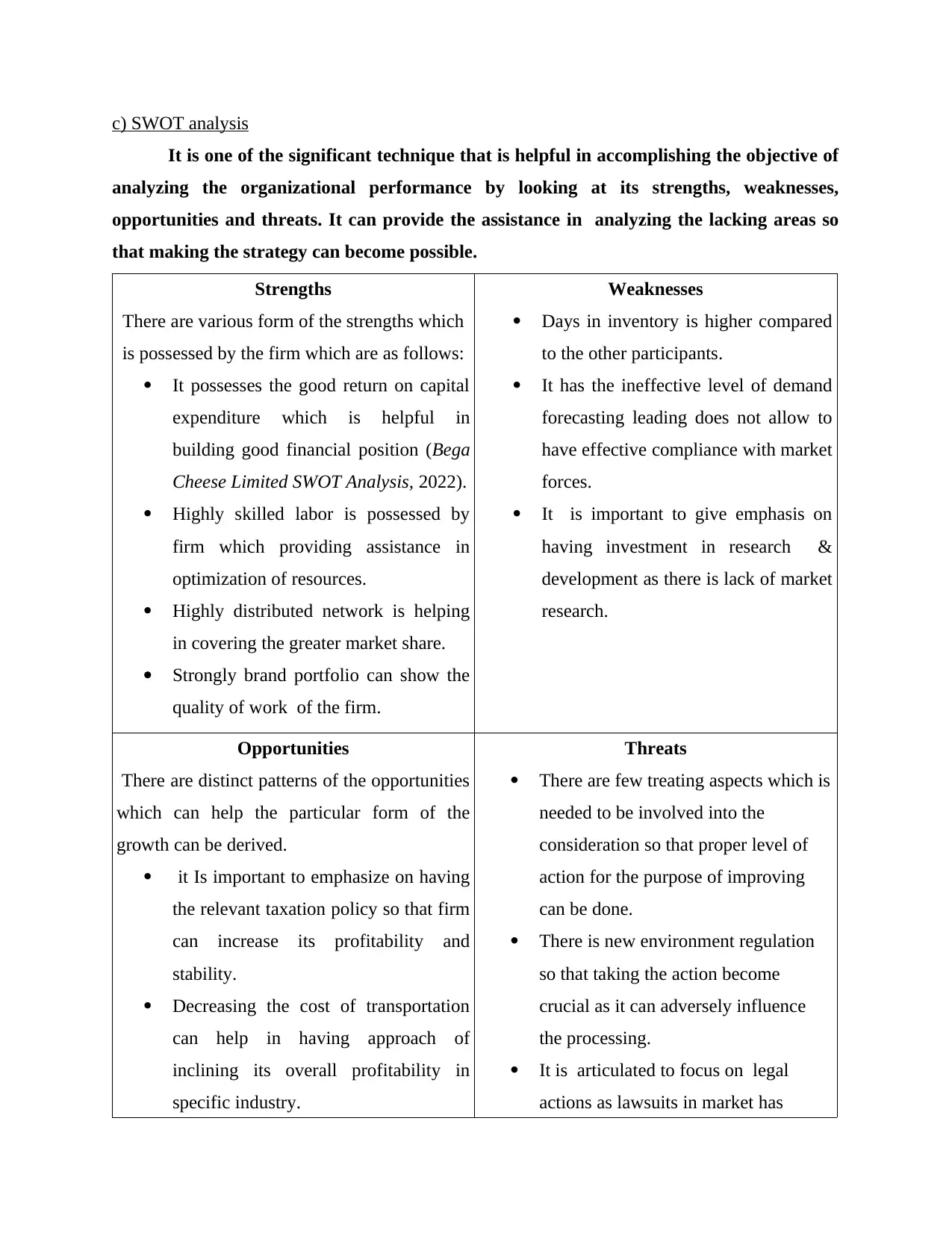
c) SWOT analysis
It is one of the significant technique that is helpful in accomplishing the objective of
analyzing the organizational performance by looking at its strengths, weaknesses,
opportunities and threats. It can provide the assistance in analyzing the lacking areas so
that making the strategy can become possible.
Strengths
There are various form of the strengths which
is possessed by the firm which are as follows:
It possesses the good return on capital
expenditure which is helpful in
building good financial position (Bega
Cheese Limited SWOT Analysis, 2022).
Highly skilled labor is possessed by
firm which providing assistance in
optimization of resources.
Highly distributed network is helping
in covering the greater market share.
Strongly brand portfolio can show the
quality of work of the firm.
Weaknesses
Days in inventory is higher compared
to the other participants.
It has the ineffective level of demand
forecasting leading does not allow to
have effective compliance with market
forces.
It is important to give emphasis on
having investment in research &
development as there is lack of market
research.
Opportunities
There are distinct patterns of the opportunities
which can help the particular form of the
growth can be derived.
it Is important to emphasize on having
the relevant taxation policy so that firm
can increase its profitability and
stability.
Decreasing the cost of transportation
can help in having approach of
inclining its overall profitability in
specific industry.
Threats
There are few treating aspects which is
needed to be involved into the
consideration so that proper level of
action for the purpose of improving
can be done.
There is new environment regulation
so that taking the action become
crucial as it can adversely influence
the processing.
It is articulated to focus on legal
actions as lawsuits in market has
It is one of the significant technique that is helpful in accomplishing the objective of
analyzing the organizational performance by looking at its strengths, weaknesses,
opportunities and threats. It can provide the assistance in analyzing the lacking areas so
that making the strategy can become possible.
Strengths
There are various form of the strengths which
is possessed by the firm which are as follows:
It possesses the good return on capital
expenditure which is helpful in
building good financial position (Bega
Cheese Limited SWOT Analysis, 2022).
Highly skilled labor is possessed by
firm which providing assistance in
optimization of resources.
Highly distributed network is helping
in covering the greater market share.
Strongly brand portfolio can show the
quality of work of the firm.
Weaknesses
Days in inventory is higher compared
to the other participants.
It has the ineffective level of demand
forecasting leading does not allow to
have effective compliance with market
forces.
It is important to give emphasis on
having investment in research &
development as there is lack of market
research.
Opportunities
There are distinct patterns of the opportunities
which can help the particular form of the
growth can be derived.
it Is important to emphasize on having
the relevant taxation policy so that firm
can increase its profitability and
stability.
Decreasing the cost of transportation
can help in having approach of
inclining its overall profitability in
specific industry.
Threats
There are few treating aspects which is
needed to be involved into the
consideration so that proper level of
action for the purpose of improving
can be done.
There is new environment regulation
so that taking the action become
crucial as it can adversely influence
the processing.
It is articulated to focus on legal
actions as lawsuits in market has
Paraphrase This Document
Need a fresh take? Get an instant paraphrase of this document with our AI Paraphraser
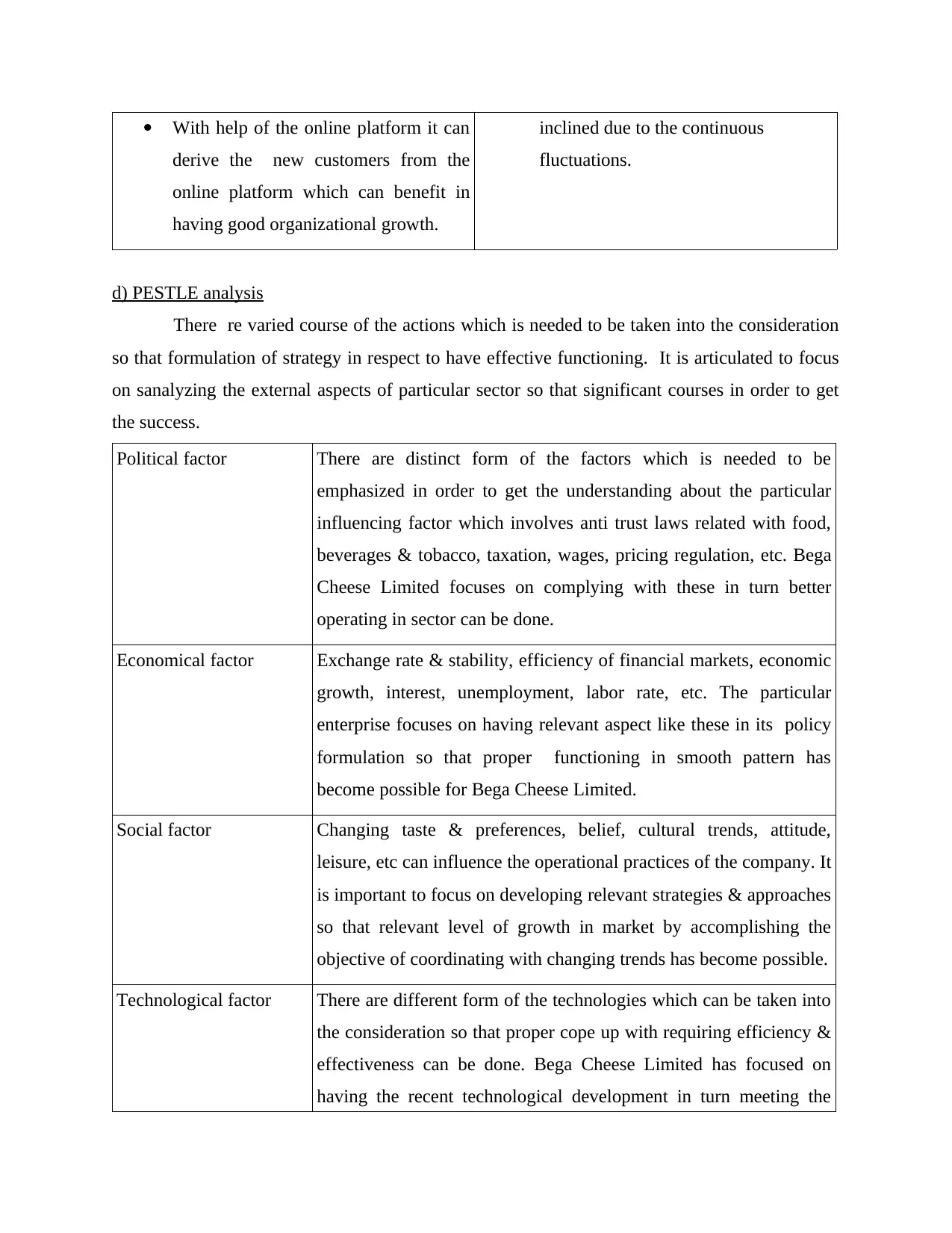
With help of the online platform it can
derive the new customers from the
online platform which can benefit in
having good organizational growth.
inclined due to the continuous
fluctuations.
d) PESTLE analysis
There re varied course of the actions which is needed to be taken into the consideration
so that formulation of strategy in respect to have effective functioning. It is articulated to focus
on sanalyzing the external aspects of particular sector so that significant courses in order to get
the success.
Political factor There are distinct form of the factors which is needed to be
emphasized in order to get the understanding about the particular
influencing factor which involves anti trust laws related with food,
beverages & tobacco, taxation, wages, pricing regulation, etc. Bega
Cheese Limited focuses on complying with these in turn better
operating in sector can be done.
Economical factor Exchange rate & stability, efficiency of financial markets, economic
growth, interest, unemployment, labor rate, etc. The particular
enterprise focuses on having relevant aspect like these in its policy
formulation so that proper functioning in smooth pattern has
become possible for Bega Cheese Limited.
Social factor Changing taste & preferences, belief, cultural trends, attitude,
leisure, etc can influence the operational practices of the company. It
is important to focus on developing relevant strategies & approaches
so that relevant level of growth in market by accomplishing the
objective of coordinating with changing trends has become possible.
Technological factor There are different form of the technologies which can be taken into
the consideration so that proper cope up with requiring efficiency &
effectiveness can be done. Bega Cheese Limited has focused on
having the recent technological development in turn meeting the
derive the new customers from the
online platform which can benefit in
having good organizational growth.
inclined due to the continuous
fluctuations.
d) PESTLE analysis
There re varied course of the actions which is needed to be taken into the consideration
so that formulation of strategy in respect to have effective functioning. It is articulated to focus
on sanalyzing the external aspects of particular sector so that significant courses in order to get
the success.
Political factor There are distinct form of the factors which is needed to be
emphasized in order to get the understanding about the particular
influencing factor which involves anti trust laws related with food,
beverages & tobacco, taxation, wages, pricing regulation, etc. Bega
Cheese Limited focuses on complying with these in turn better
operating in sector can be done.
Economical factor Exchange rate & stability, efficiency of financial markets, economic
growth, interest, unemployment, labor rate, etc. The particular
enterprise focuses on having relevant aspect like these in its policy
formulation so that proper functioning in smooth pattern has
become possible for Bega Cheese Limited.
Social factor Changing taste & preferences, belief, cultural trends, attitude,
leisure, etc can influence the operational practices of the company. It
is important to focus on developing relevant strategies & approaches
so that relevant level of growth in market by accomplishing the
objective of coordinating with changing trends has become possible.
Technological factor There are different form of the technologies which can be taken into
the consideration so that proper cope up with requiring efficiency &
effectiveness can be done. Bega Cheese Limited has focused on
having the recent technological development in turn meeting the
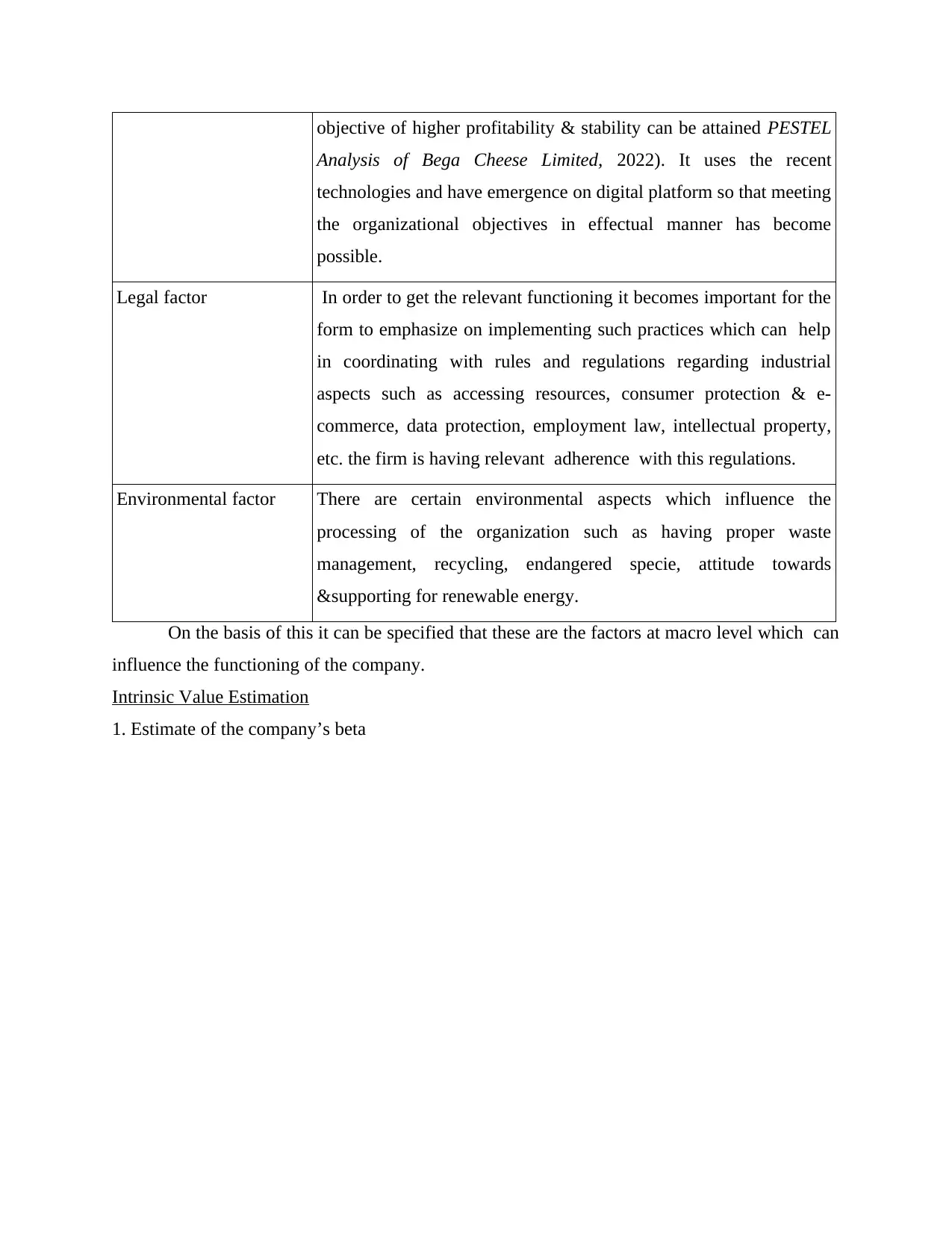
objective of higher profitability & stability can be attained PESTEL
Analysis of Bega Cheese Limited, 2022). It uses the recent
technologies and have emergence on digital platform so that meeting
the organizational objectives in effectual manner has become
possible.
Legal factor In order to get the relevant functioning it becomes important for the
form to emphasize on implementing such practices which can help
in coordinating with rules and regulations regarding industrial
aspects such as accessing resources, consumer protection & e-
commerce, data protection, employment law, intellectual property,
etc. the firm is having relevant adherence with this regulations.
Environmental factor There are certain environmental aspects which influence the
processing of the organization such as having proper waste
management, recycling, endangered specie, attitude towards
&supporting for renewable energy.
On the basis of this it can be specified that these are the factors at macro level which can
influence the functioning of the company.
Intrinsic Value Estimation
1. Estimate of the company’s beta
Analysis of Bega Cheese Limited, 2022). It uses the recent
technologies and have emergence on digital platform so that meeting
the organizational objectives in effectual manner has become
possible.
Legal factor In order to get the relevant functioning it becomes important for the
form to emphasize on implementing such practices which can help
in coordinating with rules and regulations regarding industrial
aspects such as accessing resources, consumer protection & e-
commerce, data protection, employment law, intellectual property,
etc. the firm is having relevant adherence with this regulations.
Environmental factor There are certain environmental aspects which influence the
processing of the organization such as having proper waste
management, recycling, endangered specie, attitude towards
&supporting for renewable energy.
On the basis of this it can be specified that these are the factors at macro level which can
influence the functioning of the company.
Intrinsic Value Estimation
1. Estimate of the company’s beta
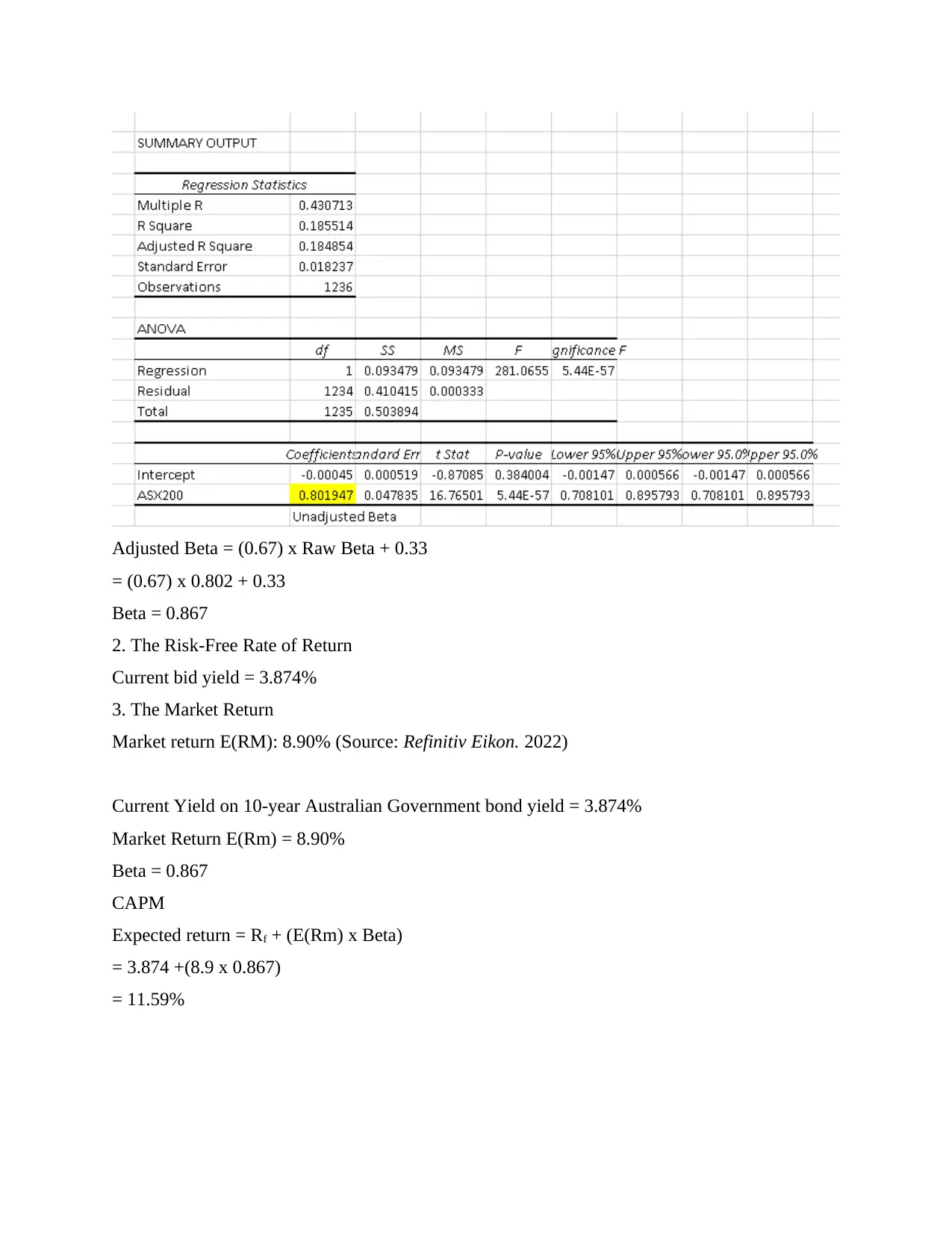
Adjusted Beta = (0.67) x Raw Beta + 0.33
= (0.67) x 0.802 + 0.33
Beta = 0.867
2. The Risk-Free Rate of Return
Current bid yield = 3.874%
3. The Market Return
Market return E(RM): 8.90% (Source: Refinitiv Eikon. 2022)
Current Yield on 10-year Australian Government bond yield = 3.874%
Market Return E(Rm) = 8.90%
Beta = 0.867
CAPM
Expected return = Rf + (E(Rm) x Beta)
= 3.874 +(8.9 x 0.867)
= 11.59%
= (0.67) x 0.802 + 0.33
Beta = 0.867
2. The Risk-Free Rate of Return
Current bid yield = 3.874%
3. The Market Return
Market return E(RM): 8.90% (Source: Refinitiv Eikon. 2022)
Current Yield on 10-year Australian Government bond yield = 3.874%
Market Return E(Rm) = 8.90%
Beta = 0.867
CAPM
Expected return = Rf + (E(Rm) x Beta)
= 3.874 +(8.9 x 0.867)
= 11.59%
Secure Best Marks with AI Grader
Need help grading? Try our AI Grader for instant feedback on your assignments.
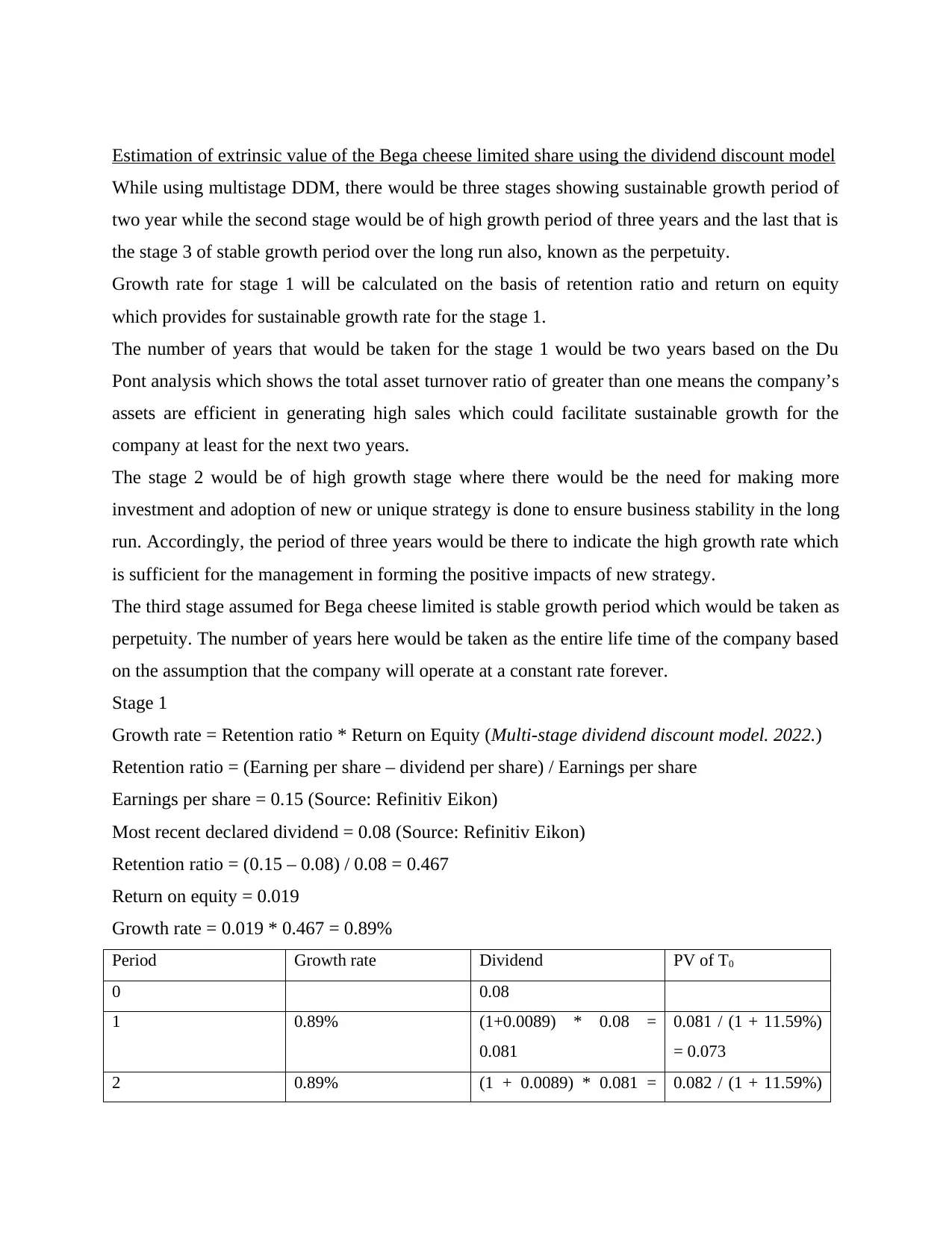
Estimation of extrinsic value of the Bega cheese limited share using the dividend discount model
While using multistage DDM, there would be three stages showing sustainable growth period of
two year while the second stage would be of high growth period of three years and the last that is
the stage 3 of stable growth period over the long run also, known as the perpetuity.
Growth rate for stage 1 will be calculated on the basis of retention ratio and return on equity
which provides for sustainable growth rate for the stage 1.
The number of years that would be taken for the stage 1 would be two years based on the Du
Pont analysis which shows the total asset turnover ratio of greater than one means the company’s
assets are efficient in generating high sales which could facilitate sustainable growth for the
company at least for the next two years.
The stage 2 would be of high growth stage where there would be the need for making more
investment and adoption of new or unique strategy is done to ensure business stability in the long
run. Accordingly, the period of three years would be there to indicate the high growth rate which
is sufficient for the management in forming the positive impacts of new strategy.
The third stage assumed for Bega cheese limited is stable growth period which would be taken as
perpetuity. The number of years here would be taken as the entire life time of the company based
on the assumption that the company will operate at a constant rate forever.
Stage 1
Growth rate = Retention ratio * Return on Equity (Multi-stage dividend discount model. 2022.)
Retention ratio = (Earning per share – dividend per share) / Earnings per share
Earnings per share = 0.15 (Source: Refinitiv Eikon)
Most recent declared dividend = 0.08 (Source: Refinitiv Eikon)
Retention ratio = (0.15 – 0.08) / 0.08 = 0.467
Return on equity = 0.019
Growth rate = 0.019 * 0.467 = 0.89%
Period Growth rate Dividend PV of T0
0 0.08
1 0.89% (1+0.0089) * 0.08 =
0.081
0.081 / (1 + 11.59%)
= 0.073
2 0.89% (1 + 0.0089) * 0.081 = 0.082 / (1 + 11.59%)
While using multistage DDM, there would be three stages showing sustainable growth period of
two year while the second stage would be of high growth period of three years and the last that is
the stage 3 of stable growth period over the long run also, known as the perpetuity.
Growth rate for stage 1 will be calculated on the basis of retention ratio and return on equity
which provides for sustainable growth rate for the stage 1.
The number of years that would be taken for the stage 1 would be two years based on the Du
Pont analysis which shows the total asset turnover ratio of greater than one means the company’s
assets are efficient in generating high sales which could facilitate sustainable growth for the
company at least for the next two years.
The stage 2 would be of high growth stage where there would be the need for making more
investment and adoption of new or unique strategy is done to ensure business stability in the long
run. Accordingly, the period of three years would be there to indicate the high growth rate which
is sufficient for the management in forming the positive impacts of new strategy.
The third stage assumed for Bega cheese limited is stable growth period which would be taken as
perpetuity. The number of years here would be taken as the entire life time of the company based
on the assumption that the company will operate at a constant rate forever.
Stage 1
Growth rate = Retention ratio * Return on Equity (Multi-stage dividend discount model. 2022.)
Retention ratio = (Earning per share – dividend per share) / Earnings per share
Earnings per share = 0.15 (Source: Refinitiv Eikon)
Most recent declared dividend = 0.08 (Source: Refinitiv Eikon)
Retention ratio = (0.15 – 0.08) / 0.08 = 0.467
Return on equity = 0.019
Growth rate = 0.019 * 0.467 = 0.89%
Period Growth rate Dividend PV of T0
0 0.08
1 0.89% (1+0.0089) * 0.08 =
0.081
0.081 / (1 + 11.59%)
= 0.073
2 0.89% (1 + 0.0089) * 0.081 = 0.082 / (1 + 11.59%)
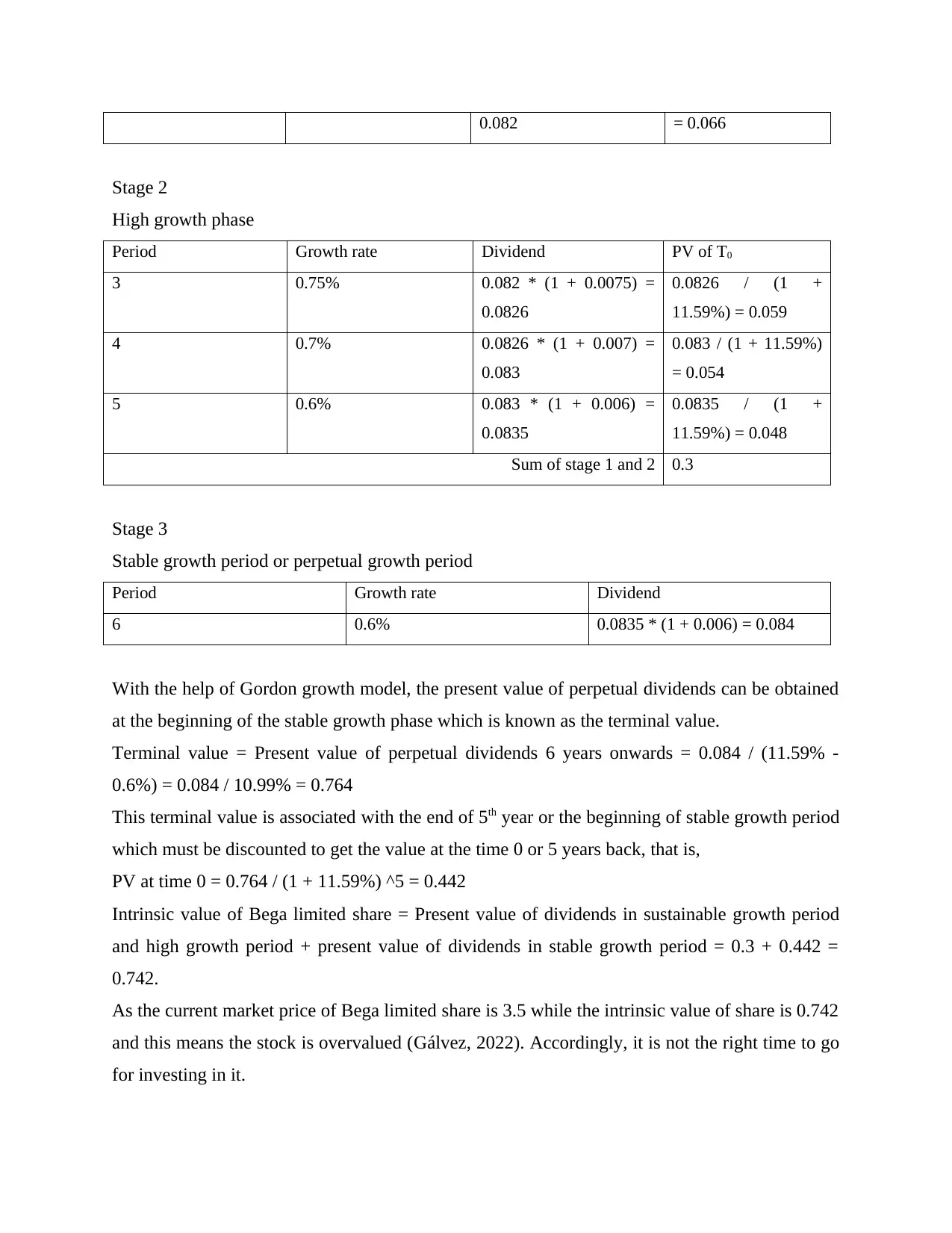
0.082 = 0.066
Stage 2
High growth phase
Period Growth rate Dividend PV of T0
3 0.75% 0.082 * (1 + 0.0075) =
0.0826
0.0826 / (1 +
11.59%) = 0.059
4 0.7% 0.0826 * (1 + 0.007) =
0.083
0.083 / (1 + 11.59%)
= 0.054
5 0.6% 0.083 * (1 + 0.006) =
0.0835
0.0835 / (1 +
11.59%) = 0.048
Sum of stage 1 and 2 0.3
Stage 3
Stable growth period or perpetual growth period
Period Growth rate Dividend
6 0.6% 0.0835 * (1 + 0.006) = 0.084
With the help of Gordon growth model, the present value of perpetual dividends can be obtained
at the beginning of the stable growth phase which is known as the terminal value.
Terminal value = Present value of perpetual dividends 6 years onwards = 0.084 / (11.59% -
0.6%) = 0.084 / 10.99% = 0.764
This terminal value is associated with the end of 5th year or the beginning of stable growth period
which must be discounted to get the value at the time 0 or 5 years back, that is,
PV at time 0 = 0.764 / (1 + 11.59%) ^5 = 0.442
Intrinsic value of Bega limited share = Present value of dividends in sustainable growth period
and high growth period + present value of dividends in stable growth period = 0.3 + 0.442 =
0.742.
As the current market price of Bega limited share is 3.5 while the intrinsic value of share is 0.742
and this means the stock is overvalued (Gálvez, 2022). Accordingly, it is not the right time to go
for investing in it.
Stage 2
High growth phase
Period Growth rate Dividend PV of T0
3 0.75% 0.082 * (1 + 0.0075) =
0.0826
0.0826 / (1 +
11.59%) = 0.059
4 0.7% 0.0826 * (1 + 0.007) =
0.083
0.083 / (1 + 11.59%)
= 0.054
5 0.6% 0.083 * (1 + 0.006) =
0.0835
0.0835 / (1 +
11.59%) = 0.048
Sum of stage 1 and 2 0.3
Stage 3
Stable growth period or perpetual growth period
Period Growth rate Dividend
6 0.6% 0.0835 * (1 + 0.006) = 0.084
With the help of Gordon growth model, the present value of perpetual dividends can be obtained
at the beginning of the stable growth phase which is known as the terminal value.
Terminal value = Present value of perpetual dividends 6 years onwards = 0.084 / (11.59% -
0.6%) = 0.084 / 10.99% = 0.764
This terminal value is associated with the end of 5th year or the beginning of stable growth period
which must be discounted to get the value at the time 0 or 5 years back, that is,
PV at time 0 = 0.764 / (1 + 11.59%) ^5 = 0.442
Intrinsic value of Bega limited share = Present value of dividends in sustainable growth period
and high growth period + present value of dividends in stable growth period = 0.3 + 0.442 =
0.742.
As the current market price of Bega limited share is 3.5 while the intrinsic value of share is 0.742
and this means the stock is overvalued (Gálvez, 2022). Accordingly, it is not the right time to go
for investing in it.
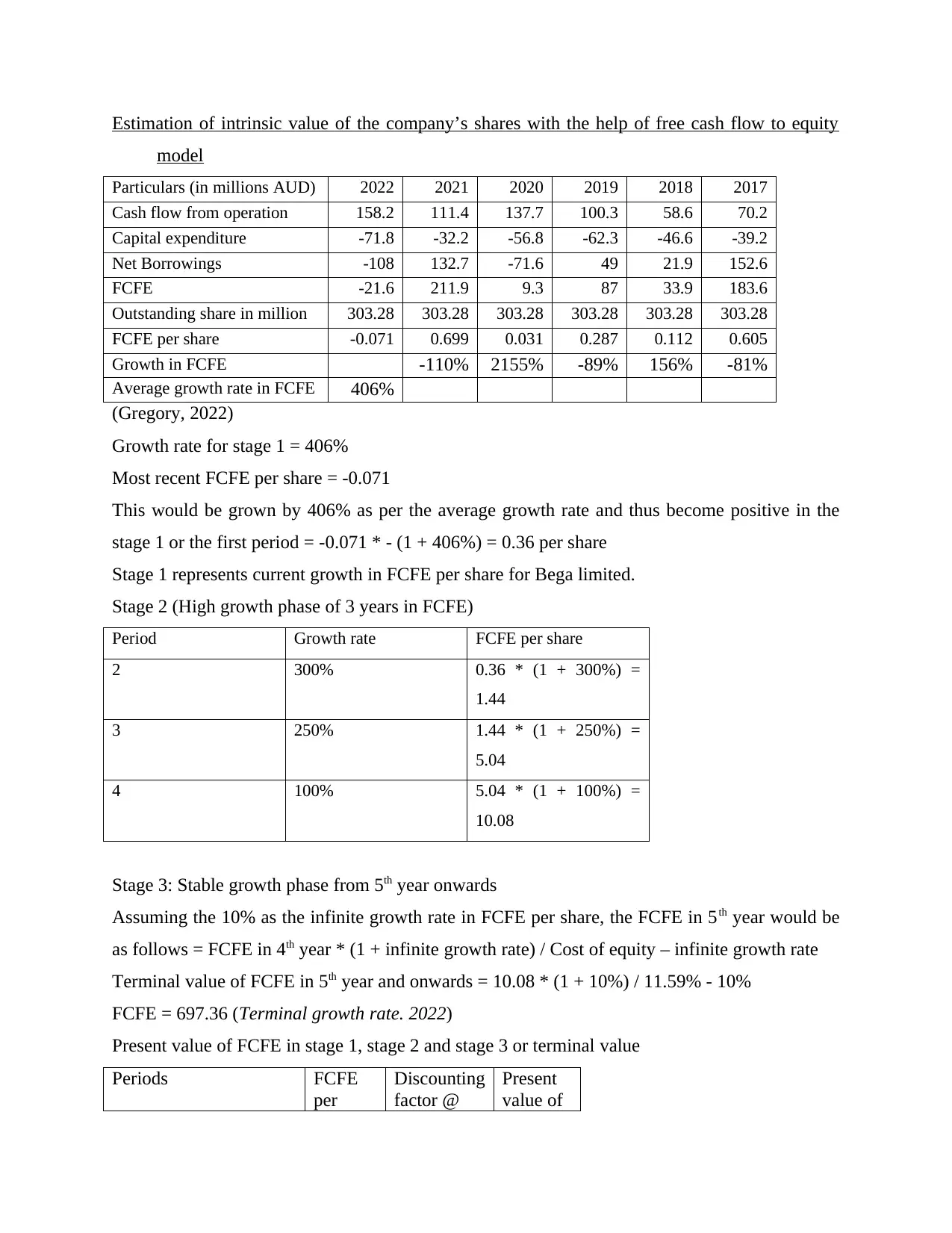
Estimation of intrinsic value of the company’s shares with the help of free cash flow to equity
model
Particulars (in millions AUD) 2022 2021 2020 2019 2018 2017
Cash flow from operation 158.2 111.4 137.7 100.3 58.6 70.2
Capital expenditure -71.8 -32.2 -56.8 -62.3 -46.6 -39.2
Net Borrowings -108 132.7 -71.6 49 21.9 152.6
FCFE -21.6 211.9 9.3 87 33.9 183.6
Outstanding share in million 303.28 303.28 303.28 303.28 303.28 303.28
FCFE per share -0.071 0.699 0.031 0.287 0.112 0.605
Growth in FCFE -110% 2155% -89% 156% -81%
Average growth rate in FCFE 406%
(Gregory, 2022)
Growth rate for stage 1 = 406%
Most recent FCFE per share = -0.071
This would be grown by 406% as per the average growth rate and thus become positive in the
stage 1 or the first period = -0.071 * - (1 + 406%) = 0.36 per share
Stage 1 represents current growth in FCFE per share for Bega limited.
Stage 2 (High growth phase of 3 years in FCFE)
Period Growth rate FCFE per share
2 300% 0.36 * (1 + 300%) =
1.44
3 250% 1.44 * (1 + 250%) =
5.04
4 100% 5.04 * (1 + 100%) =
10.08
Stage 3: Stable growth phase from 5th year onwards
Assuming the 10% as the infinite growth rate in FCFE per share, the FCFE in 5th year would be
as follows = FCFE in 4th year * (1 + infinite growth rate) / Cost of equity – infinite growth rate
Terminal value of FCFE in 5th year and onwards = 10.08 * (1 + 10%) / 11.59% - 10%
FCFE = 697.36 (Terminal growth rate. 2022)
Present value of FCFE in stage 1, stage 2 and stage 3 or terminal value
Periods FCFE
per
Discounting
factor @
Present
value of
model
Particulars (in millions AUD) 2022 2021 2020 2019 2018 2017
Cash flow from operation 158.2 111.4 137.7 100.3 58.6 70.2
Capital expenditure -71.8 -32.2 -56.8 -62.3 -46.6 -39.2
Net Borrowings -108 132.7 -71.6 49 21.9 152.6
FCFE -21.6 211.9 9.3 87 33.9 183.6
Outstanding share in million 303.28 303.28 303.28 303.28 303.28 303.28
FCFE per share -0.071 0.699 0.031 0.287 0.112 0.605
Growth in FCFE -110% 2155% -89% 156% -81%
Average growth rate in FCFE 406%
(Gregory, 2022)
Growth rate for stage 1 = 406%
Most recent FCFE per share = -0.071
This would be grown by 406% as per the average growth rate and thus become positive in the
stage 1 or the first period = -0.071 * - (1 + 406%) = 0.36 per share
Stage 1 represents current growth in FCFE per share for Bega limited.
Stage 2 (High growth phase of 3 years in FCFE)
Period Growth rate FCFE per share
2 300% 0.36 * (1 + 300%) =
1.44
3 250% 1.44 * (1 + 250%) =
5.04
4 100% 5.04 * (1 + 100%) =
10.08
Stage 3: Stable growth phase from 5th year onwards
Assuming the 10% as the infinite growth rate in FCFE per share, the FCFE in 5th year would be
as follows = FCFE in 4th year * (1 + infinite growth rate) / Cost of equity – infinite growth rate
Terminal value of FCFE in 5th year and onwards = 10.08 * (1 + 10%) / 11.59% - 10%
FCFE = 697.36 (Terminal growth rate. 2022)
Present value of FCFE in stage 1, stage 2 and stage 3 or terminal value
Periods FCFE
per
Discounting
factor @
Present
value of
Paraphrase This Document
Need a fresh take? Get an instant paraphrase of this document with our AI Paraphraser
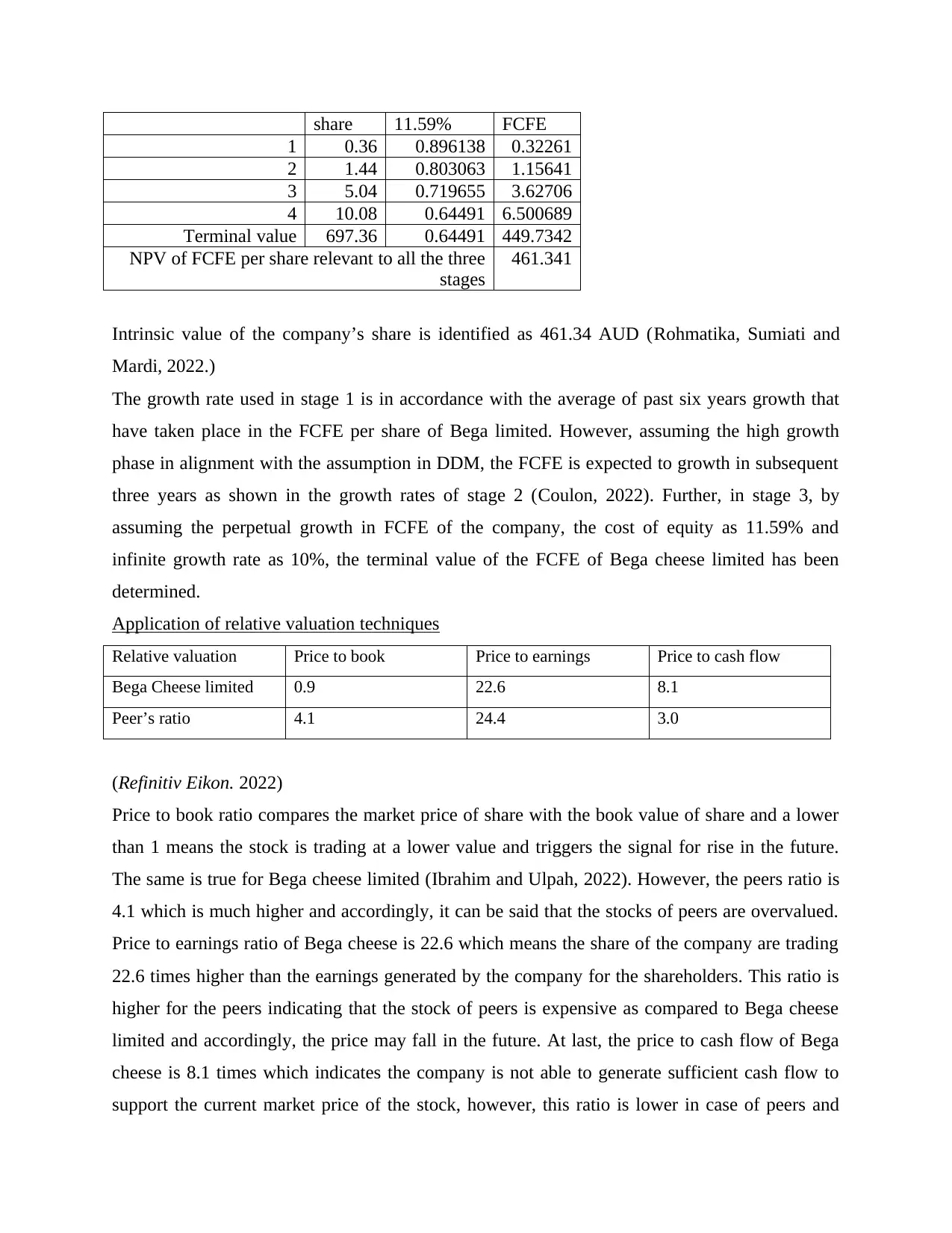
share 11.59% FCFE
1 0.36 0.896138 0.32261
2 1.44 0.803063 1.15641
3 5.04 0.719655 3.62706
4 10.08 0.64491 6.500689
Terminal value 697.36 0.64491 449.7342
NPV of FCFE per share relevant to all the three
stages
461.341
Intrinsic value of the company’s share is identified as 461.34 AUD (Rohmatika, Sumiati and
Mardi, 2022.)
The growth rate used in stage 1 is in accordance with the average of past six years growth that
have taken place in the FCFE per share of Bega limited. However, assuming the high growth
phase in alignment with the assumption in DDM, the FCFE is expected to growth in subsequent
three years as shown in the growth rates of stage 2 (Coulon, 2022). Further, in stage 3, by
assuming the perpetual growth in FCFE of the company, the cost of equity as 11.59% and
infinite growth rate as 10%, the terminal value of the FCFE of Bega cheese limited has been
determined.
Application of relative valuation techniques
Relative valuation Price to book Price to earnings Price to cash flow
Bega Cheese limited 0.9 22.6 8.1
Peer’s ratio 4.1 24.4 3.0
(Refinitiv Eikon. 2022)
Price to book ratio compares the market price of share with the book value of share and a lower
than 1 means the stock is trading at a lower value and triggers the signal for rise in the future.
The same is true for Bega cheese limited (Ibrahim and Ulpah, 2022). However, the peers ratio is
4.1 which is much higher and accordingly, it can be said that the stocks of peers are overvalued.
Price to earnings ratio of Bega cheese is 22.6 which means the share of the company are trading
22.6 times higher than the earnings generated by the company for the shareholders. This ratio is
higher for the peers indicating that the stock of peers is expensive as compared to Bega cheese
limited and accordingly, the price may fall in the future. At last, the price to cash flow of Bega
cheese is 8.1 times which indicates the company is not able to generate sufficient cash flow to
support the current market price of the stock, however, this ratio is lower in case of peers and
1 0.36 0.896138 0.32261
2 1.44 0.803063 1.15641
3 5.04 0.719655 3.62706
4 10.08 0.64491 6.500689
Terminal value 697.36 0.64491 449.7342
NPV of FCFE per share relevant to all the three
stages
461.341
Intrinsic value of the company’s share is identified as 461.34 AUD (Rohmatika, Sumiati and
Mardi, 2022.)
The growth rate used in stage 1 is in accordance with the average of past six years growth that
have taken place in the FCFE per share of Bega limited. However, assuming the high growth
phase in alignment with the assumption in DDM, the FCFE is expected to growth in subsequent
three years as shown in the growth rates of stage 2 (Coulon, 2022). Further, in stage 3, by
assuming the perpetual growth in FCFE of the company, the cost of equity as 11.59% and
infinite growth rate as 10%, the terminal value of the FCFE of Bega cheese limited has been
determined.
Application of relative valuation techniques
Relative valuation Price to book Price to earnings Price to cash flow
Bega Cheese limited 0.9 22.6 8.1
Peer’s ratio 4.1 24.4 3.0
(Refinitiv Eikon. 2022)
Price to book ratio compares the market price of share with the book value of share and a lower
than 1 means the stock is trading at a lower value and triggers the signal for rise in the future.
The same is true for Bega cheese limited (Ibrahim and Ulpah, 2022). However, the peers ratio is
4.1 which is much higher and accordingly, it can be said that the stocks of peers are overvalued.
Price to earnings ratio of Bega cheese is 22.6 which means the share of the company are trading
22.6 times higher than the earnings generated by the company for the shareholders. This ratio is
higher for the peers indicating that the stock of peers is expensive as compared to Bega cheese
limited and accordingly, the price may fall in the future. At last, the price to cash flow of Bega
cheese is 8.1 times which indicates the company is not able to generate sufficient cash flow to
support the current market price of the stock, however, this ratio is lower in case of peers and
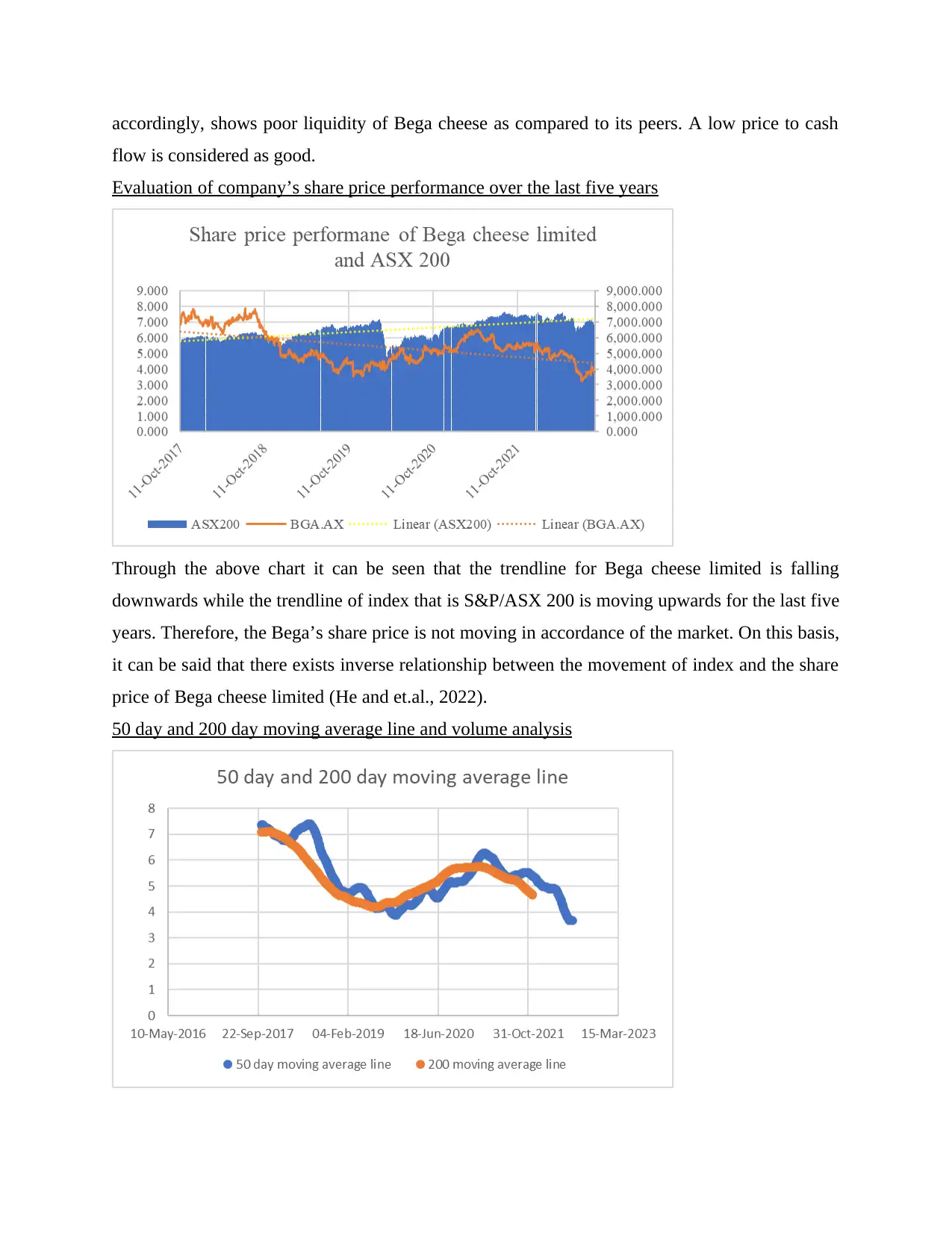
accordingly, shows poor liquidity of Bega cheese as compared to its peers. A low price to cash
flow is considered as good.
Evaluation of company’s share price performance over the last five years
Through the above chart it can be seen that the trendline for Bega cheese limited is falling
downwards while the trendline of index that is S&P/ASX 200 is moving upwards for the last five
years. Therefore, the Bega’s share price is not moving in accordance of the market. On this basis,
it can be said that there exists inverse relationship between the movement of index and the share
price of Bega cheese limited (He and et.al., 2022).
50 day and 200 day moving average line and volume analysis
flow is considered as good.
Evaluation of company’s share price performance over the last five years
Through the above chart it can be seen that the trendline for Bega cheese limited is falling
downwards while the trendline of index that is S&P/ASX 200 is moving upwards for the last five
years. Therefore, the Bega’s share price is not moving in accordance of the market. On this basis,
it can be said that there exists inverse relationship between the movement of index and the share
price of Bega cheese limited (He and et.al., 2022).
50 day and 200 day moving average line and volume analysis
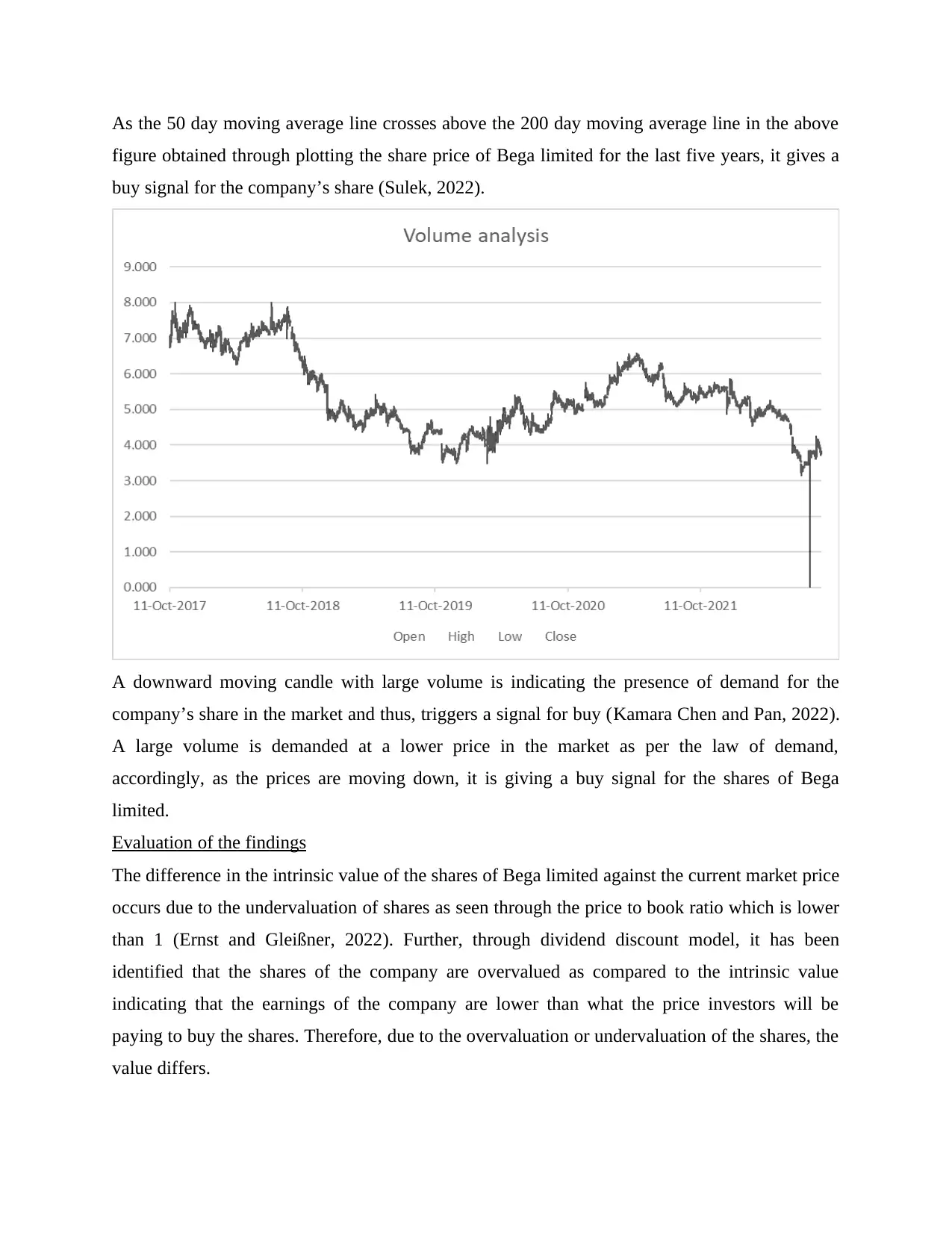
As the 50 day moving average line crosses above the 200 day moving average line in the above
figure obtained through plotting the share price of Bega limited for the last five years, it gives a
buy signal for the company’s share (Sulek, 2022).
A downward moving candle with large volume is indicating the presence of demand for the
company’s share in the market and thus, triggers a signal for buy (Kamara Chen and Pan, 2022).
A large volume is demanded at a lower price in the market as per the law of demand,
accordingly, as the prices are moving down, it is giving a buy signal for the shares of Bega
limited.
Evaluation of the findings
The difference in the intrinsic value of the shares of Bega limited against the current market price
occurs due to the undervaluation of shares as seen through the price to book ratio which is lower
than 1 (Ernst and Gleißner, 2022). Further, through dividend discount model, it has been
identified that the shares of the company are overvalued as compared to the intrinsic value
indicating that the earnings of the company are lower than what the price investors will be
paying to buy the shares. Therefore, due to the overvaluation or undervaluation of the shares, the
value differs.
figure obtained through plotting the share price of Bega limited for the last five years, it gives a
buy signal for the company’s share (Sulek, 2022).
A downward moving candle with large volume is indicating the presence of demand for the
company’s share in the market and thus, triggers a signal for buy (Kamara Chen and Pan, 2022).
A large volume is demanded at a lower price in the market as per the law of demand,
accordingly, as the prices are moving down, it is giving a buy signal for the shares of Bega
limited.
Evaluation of the findings
The difference in the intrinsic value of the shares of Bega limited against the current market price
occurs due to the undervaluation of shares as seen through the price to book ratio which is lower
than 1 (Ernst and Gleißner, 2022). Further, through dividend discount model, it has been
identified that the shares of the company are overvalued as compared to the intrinsic value
indicating that the earnings of the company are lower than what the price investors will be
paying to buy the shares. Therefore, due to the overvaluation or undervaluation of the shares, the
value differs.
Secure Best Marks with AI Grader
Need help grading? Try our AI Grader for instant feedback on your assignments.
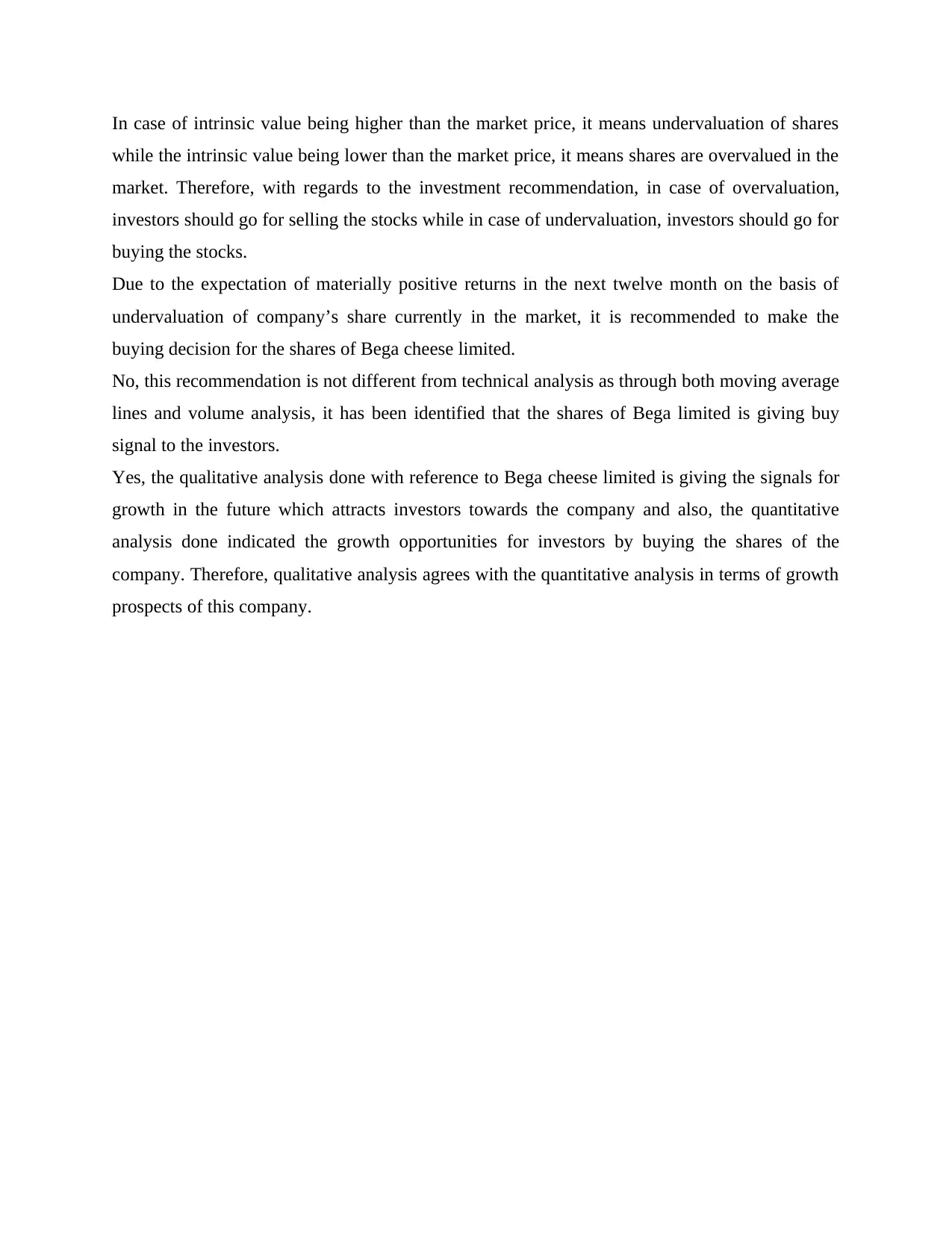
In case of intrinsic value being higher than the market price, it means undervaluation of shares
while the intrinsic value being lower than the market price, it means shares are overvalued in the
market. Therefore, with regards to the investment recommendation, in case of overvaluation,
investors should go for selling the stocks while in case of undervaluation, investors should go for
buying the stocks.
Due to the expectation of materially positive returns in the next twelve month on the basis of
undervaluation of company’s share currently in the market, it is recommended to make the
buying decision for the shares of Bega cheese limited.
No, this recommendation is not different from technical analysis as through both moving average
lines and volume analysis, it has been identified that the shares of Bega limited is giving buy
signal to the investors.
Yes, the qualitative analysis done with reference to Bega cheese limited is giving the signals for
growth in the future which attracts investors towards the company and also, the quantitative
analysis done indicated the growth opportunities for investors by buying the shares of the
company. Therefore, qualitative analysis agrees with the quantitative analysis in terms of growth
prospects of this company.
while the intrinsic value being lower than the market price, it means shares are overvalued in the
market. Therefore, with regards to the investment recommendation, in case of overvaluation,
investors should go for selling the stocks while in case of undervaluation, investors should go for
buying the stocks.
Due to the expectation of materially positive returns in the next twelve month on the basis of
undervaluation of company’s share currently in the market, it is recommended to make the
buying decision for the shares of Bega cheese limited.
No, this recommendation is not different from technical analysis as through both moving average
lines and volume analysis, it has been identified that the shares of Bega limited is giving buy
signal to the investors.
Yes, the qualitative analysis done with reference to Bega cheese limited is giving the signals for
growth in the future which attracts investors towards the company and also, the quantitative
analysis done indicated the growth opportunities for investors by buying the shares of the
company. Therefore, qualitative analysis agrees with the quantitative analysis in terms of growth
prospects of this company.
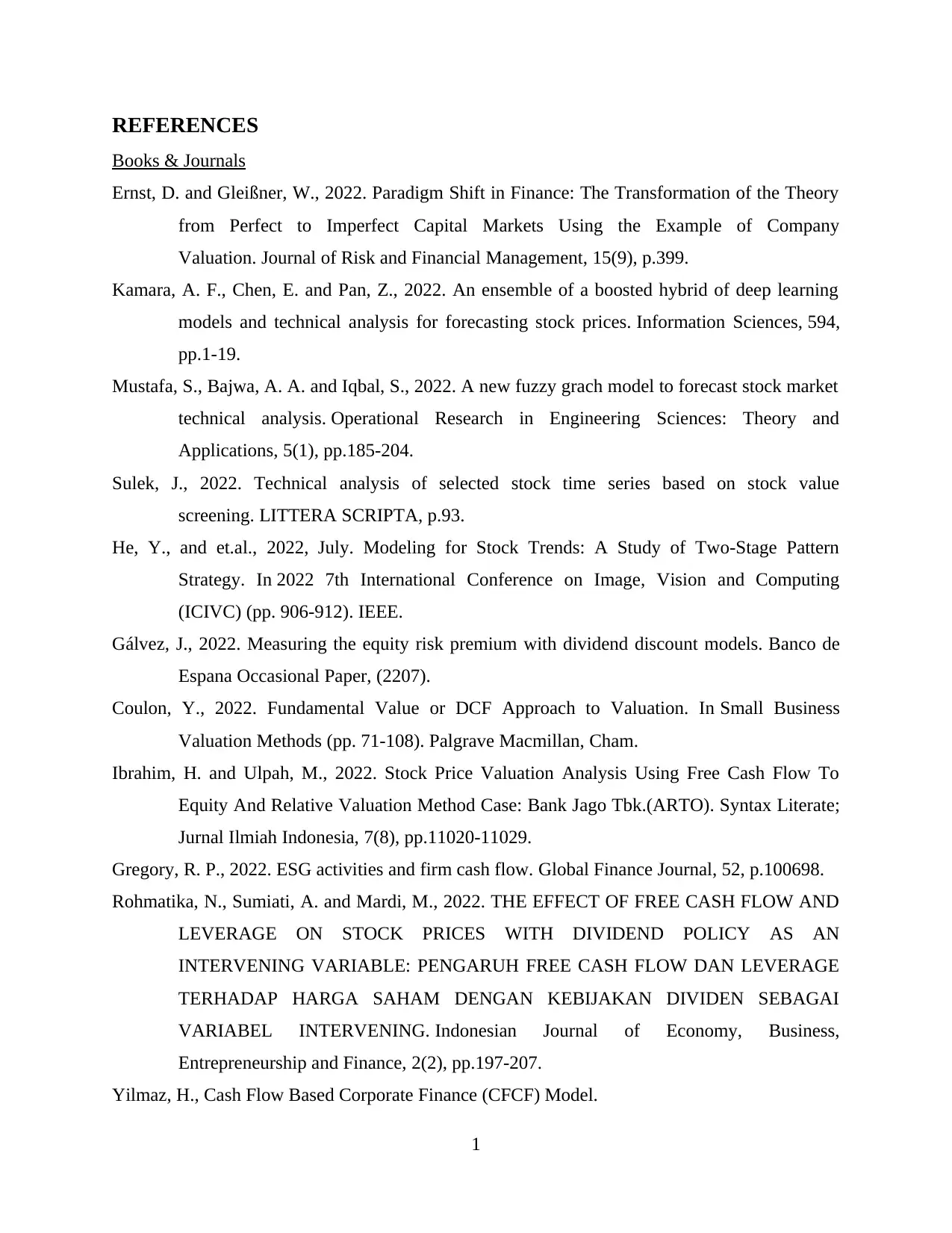
REFERENCES
Books & Journals
Ernst, D. and Gleißner, W., 2022. Paradigm Shift in Finance: The Transformation of the Theory
from Perfect to Imperfect Capital Markets Using the Example of Company
Valuation. Journal of Risk and Financial Management, 15(9), p.399.
Kamara, A. F., Chen, E. and Pan, Z., 2022. An ensemble of a boosted hybrid of deep learning
models and technical analysis for forecasting stock prices. Information Sciences, 594,
pp.1-19.
Mustafa, S., Bajwa, A. A. and Iqbal, S., 2022. A new fuzzy grach model to forecast stock market
technical analysis. Operational Research in Engineering Sciences: Theory and
Applications, 5(1), pp.185-204.
Sulek, J., 2022. Technical analysis of selected stock time series based on stock value
screening. LITTERA SCRIPTA, p.93.
He, Y., and et.al., 2022, July. Modeling for Stock Trends: A Study of Two-Stage Pattern
Strategy. In 2022 7th International Conference on Image, Vision and Computing
(ICIVC) (pp. 906-912). IEEE.
Gálvez, J., 2022. Measuring the equity risk premium with dividend discount models. Banco de
Espana Occasional Paper, (2207).
Coulon, Y., 2022. Fundamental Value or DCF Approach to Valuation. In Small Business
Valuation Methods (pp. 71-108). Palgrave Macmillan, Cham.
Ibrahim, H. and Ulpah, M., 2022. Stock Price Valuation Analysis Using Free Cash Flow To
Equity And Relative Valuation Method Case: Bank Jago Tbk.(ARTO). Syntax Literate;
Jurnal Ilmiah Indonesia, 7(8), pp.11020-11029.
Gregory, R. P., 2022. ESG activities and firm cash flow. Global Finance Journal, 52, p.100698.
Rohmatika, N., Sumiati, A. and Mardi, M., 2022. THE EFFECT OF FREE CASH FLOW AND
LEVERAGE ON STOCK PRICES WITH DIVIDEND POLICY AS AN
INTERVENING VARIABLE: PENGARUH FREE CASH FLOW DAN LEVERAGE
TERHADAP HARGA SAHAM DENGAN KEBIJAKAN DIVIDEN SEBAGAI
VARIABEL INTERVENING. Indonesian Journal of Economy, Business,
Entrepreneurship and Finance, 2(2), pp.197-207.
Yilmaz, H., Cash Flow Based Corporate Finance (CFCF) Model.
1
Books & Journals
Ernst, D. and Gleißner, W., 2022. Paradigm Shift in Finance: The Transformation of the Theory
from Perfect to Imperfect Capital Markets Using the Example of Company
Valuation. Journal of Risk and Financial Management, 15(9), p.399.
Kamara, A. F., Chen, E. and Pan, Z., 2022. An ensemble of a boosted hybrid of deep learning
models and technical analysis for forecasting stock prices. Information Sciences, 594,
pp.1-19.
Mustafa, S., Bajwa, A. A. and Iqbal, S., 2022. A new fuzzy grach model to forecast stock market
technical analysis. Operational Research in Engineering Sciences: Theory and
Applications, 5(1), pp.185-204.
Sulek, J., 2022. Technical analysis of selected stock time series based on stock value
screening. LITTERA SCRIPTA, p.93.
He, Y., and et.al., 2022, July. Modeling for Stock Trends: A Study of Two-Stage Pattern
Strategy. In 2022 7th International Conference on Image, Vision and Computing
(ICIVC) (pp. 906-912). IEEE.
Gálvez, J., 2022. Measuring the equity risk premium with dividend discount models. Banco de
Espana Occasional Paper, (2207).
Coulon, Y., 2022. Fundamental Value or DCF Approach to Valuation. In Small Business
Valuation Methods (pp. 71-108). Palgrave Macmillan, Cham.
Ibrahim, H. and Ulpah, M., 2022. Stock Price Valuation Analysis Using Free Cash Flow To
Equity And Relative Valuation Method Case: Bank Jago Tbk.(ARTO). Syntax Literate;
Jurnal Ilmiah Indonesia, 7(8), pp.11020-11029.
Gregory, R. P., 2022. ESG activities and firm cash flow. Global Finance Journal, 52, p.100698.
Rohmatika, N., Sumiati, A. and Mardi, M., 2022. THE EFFECT OF FREE CASH FLOW AND
LEVERAGE ON STOCK PRICES WITH DIVIDEND POLICY AS AN
INTERVENING VARIABLE: PENGARUH FREE CASH FLOW DAN LEVERAGE
TERHADAP HARGA SAHAM DENGAN KEBIJAKAN DIVIDEN SEBAGAI
VARIABEL INTERVENING. Indonesian Journal of Economy, Business,
Entrepreneurship and Finance, 2(2), pp.197-207.
Yilmaz, H., Cash Flow Based Corporate Finance (CFCF) Model.
1
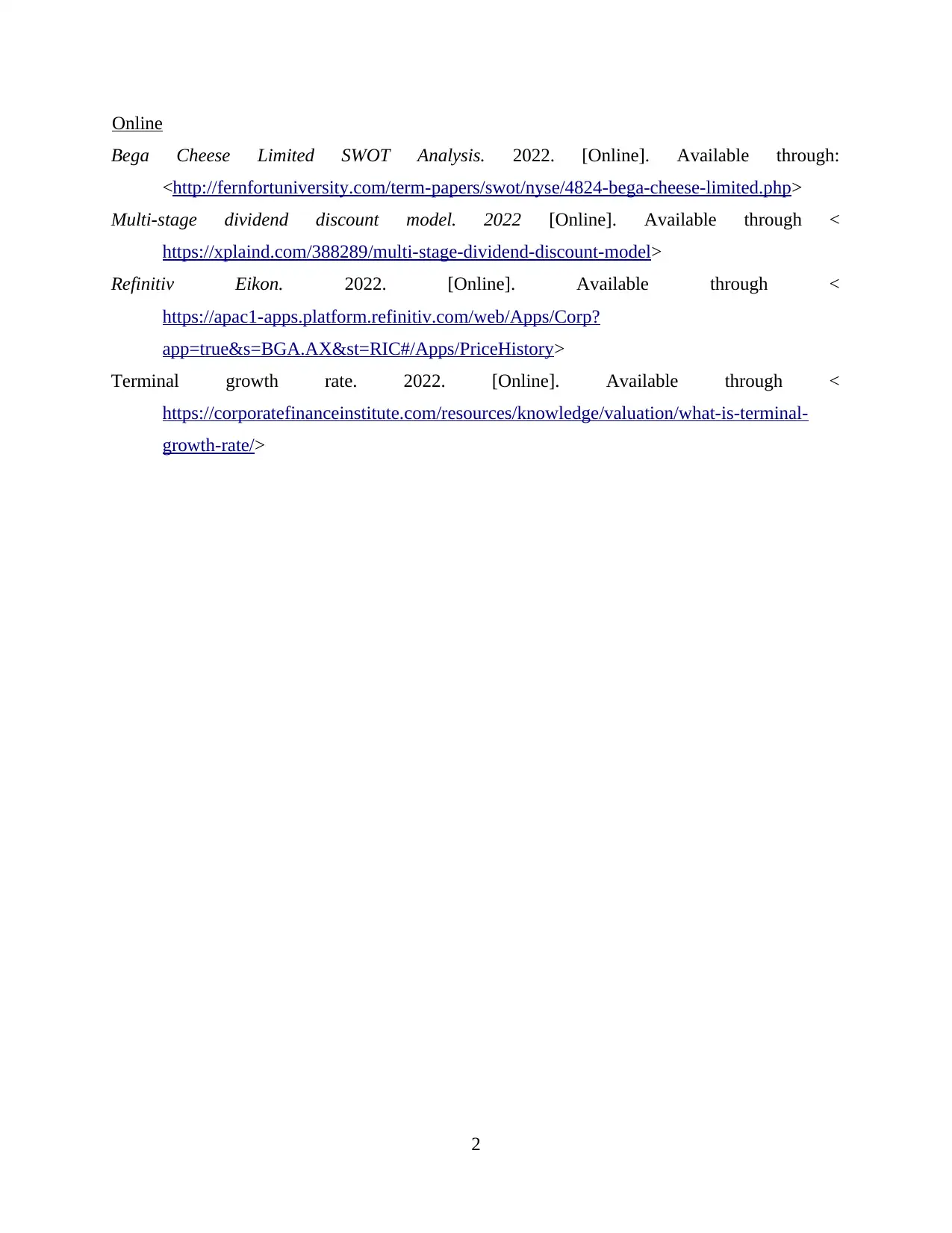
Online
Bega Cheese Limited SWOT Analysis. 2022. [Online]. Available through:
<http://fernfortuniversity.com/term-papers/swot/nyse/4824-bega-cheese-limited.php>
Multi-stage dividend discount model. 2022 [Online]. Available through <
https://xplaind.com/388289/multi-stage-dividend-discount-model>
Refinitiv Eikon. 2022. [Online]. Available through <
https://apac1-apps.platform.refinitiv.com/web/Apps/Corp?
app=true&s=BGA.AX&st=RIC#/Apps/PriceHistory>
Terminal growth rate. 2022. [Online]. Available through <
https://corporatefinanceinstitute.com/resources/knowledge/valuation/what-is-terminal-
growth-rate/>
2
Bega Cheese Limited SWOT Analysis. 2022. [Online]. Available through:
<http://fernfortuniversity.com/term-papers/swot/nyse/4824-bega-cheese-limited.php>
Multi-stage dividend discount model. 2022 [Online]. Available through <
https://xplaind.com/388289/multi-stage-dividend-discount-model>
Refinitiv Eikon. 2022. [Online]. Available through <
https://apac1-apps.platform.refinitiv.com/web/Apps/Corp?
app=true&s=BGA.AX&st=RIC#/Apps/PriceHistory>
Terminal growth rate. 2022. [Online]. Available through <
https://corporatefinanceinstitute.com/resources/knowledge/valuation/what-is-terminal-
growth-rate/>
2
Paraphrase This Document
Need a fresh take? Get an instant paraphrase of this document with our AI Paraphraser
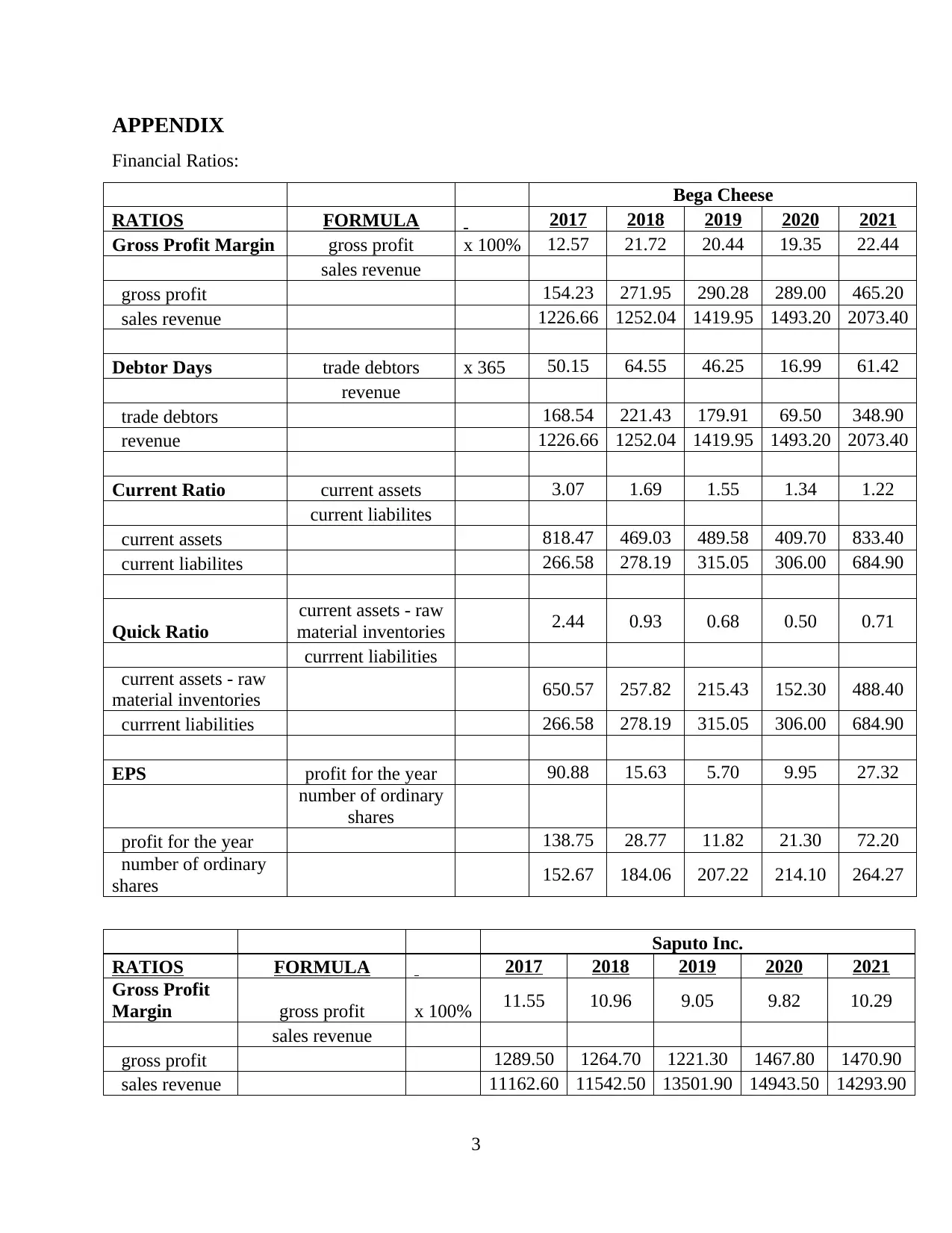
APPENDIX
Financial Ratios:
Bega Cheese
RATIOS FORMULA 2017 2018 2019 2020 2021
Gross Profit Margin gross profit x 100% 12.57 21.72 20.44 19.35 22.44
sales revenue
gross profit 154.23 271.95 290.28 289.00 465.20
sales revenue 1226.66 1252.04 1419.95 1493.20 2073.40
Debtor Days trade debtors x 365 50.15 64.55 46.25 16.99 61.42
revenue
trade debtors 168.54 221.43 179.91 69.50 348.90
revenue 1226.66 1252.04 1419.95 1493.20 2073.40
Current Ratio current assets 3.07 1.69 1.55 1.34 1.22
current liabilites
current assets 818.47 469.03 489.58 409.70 833.40
current liabilites 266.58 278.19 315.05 306.00 684.90
Quick Ratio
current assets - raw
material inventories 2.44 0.93 0.68 0.50 0.71
currrent liabilities
current assets - raw
material inventories 650.57 257.82 215.43 152.30 488.40
currrent liabilities 266.58 278.19 315.05 306.00 684.90
EPS profit for the year 90.88 15.63 5.70 9.95 27.32
number of ordinary
shares
profit for the year 138.75 28.77 11.82 21.30 72.20
number of ordinary
shares 152.67 184.06 207.22 214.10 264.27
Saputo Inc.
RATIOS FORMULA 2017 2018 2019 2020 2021
Gross Profit
Margin gross profit x 100% 11.55 10.96 9.05 9.82 10.29
sales revenue
gross profit 1289.50 1264.70 1221.30 1467.80 1470.90
sales revenue 11162.60 11542.50 13501.90 14943.50 14293.90
3
Financial Ratios:
Bega Cheese
RATIOS FORMULA 2017 2018 2019 2020 2021
Gross Profit Margin gross profit x 100% 12.57 21.72 20.44 19.35 22.44
sales revenue
gross profit 154.23 271.95 290.28 289.00 465.20
sales revenue 1226.66 1252.04 1419.95 1493.20 2073.40
Debtor Days trade debtors x 365 50.15 64.55 46.25 16.99 61.42
revenue
trade debtors 168.54 221.43 179.91 69.50 348.90
revenue 1226.66 1252.04 1419.95 1493.20 2073.40
Current Ratio current assets 3.07 1.69 1.55 1.34 1.22
current liabilites
current assets 818.47 469.03 489.58 409.70 833.40
current liabilites 266.58 278.19 315.05 306.00 684.90
Quick Ratio
current assets - raw
material inventories 2.44 0.93 0.68 0.50 0.71
currrent liabilities
current assets - raw
material inventories 650.57 257.82 215.43 152.30 488.40
currrent liabilities 266.58 278.19 315.05 306.00 684.90
EPS profit for the year 90.88 15.63 5.70 9.95 27.32
number of ordinary
shares
profit for the year 138.75 28.77 11.82 21.30 72.20
number of ordinary
shares 152.67 184.06 207.22 214.10 264.27
Saputo Inc.
RATIOS FORMULA 2017 2018 2019 2020 2021
Gross Profit
Margin gross profit x 100% 11.55 10.96 9.05 9.82 10.29
sales revenue
gross profit 1289.50 1264.70 1221.30 1467.80 1470.90
sales revenue 11162.60 11542.50 13501.90 14943.50 14293.90
3
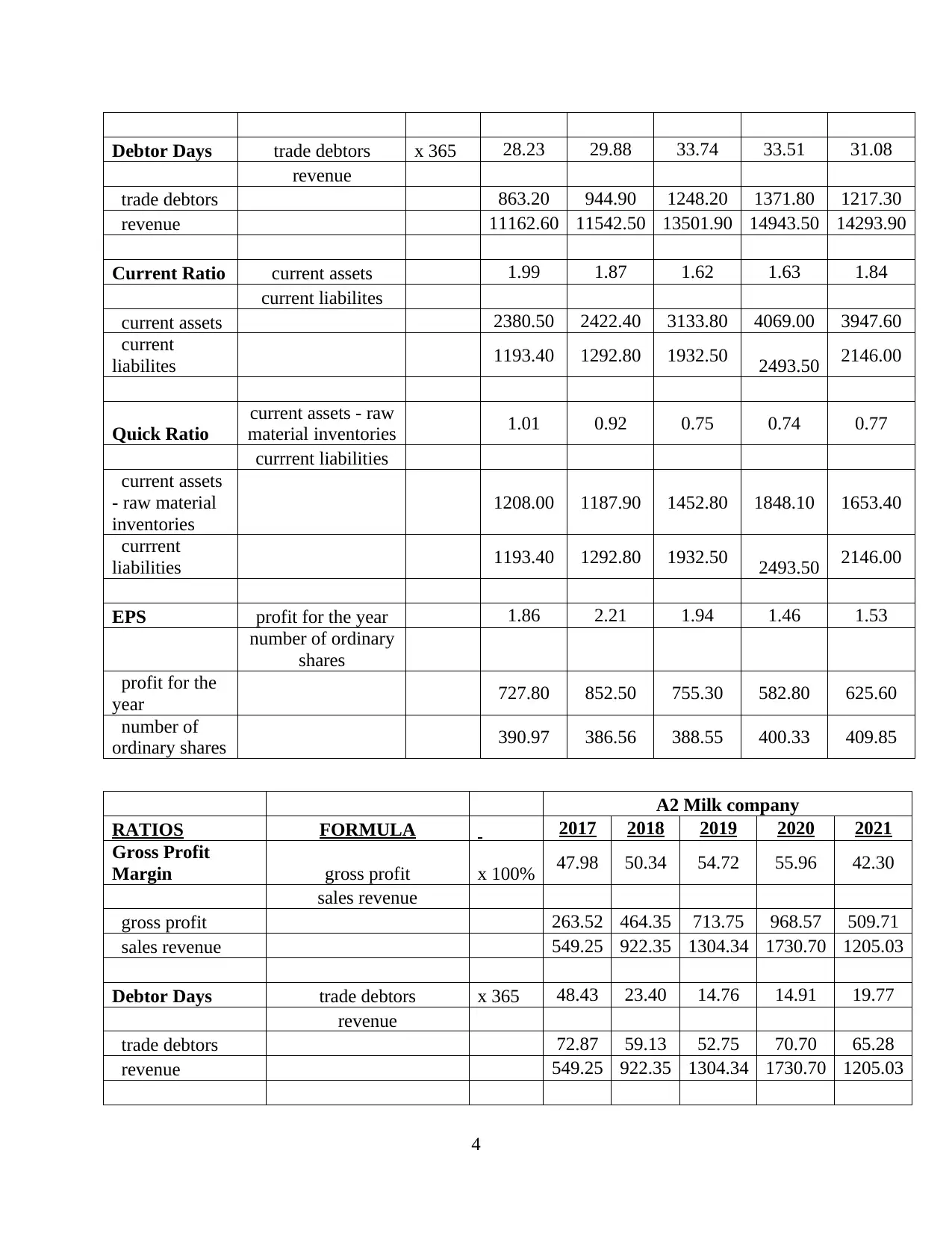
Debtor Days trade debtors x 365 28.23 29.88 33.74 33.51 31.08
revenue
trade debtors 863.20 944.90 1248.20 1371.80 1217.30
revenue 11162.60 11542.50 13501.90 14943.50 14293.90
Current Ratio current assets 1.99 1.87 1.62 1.63 1.84
current liabilites
current assets 2380.50 2422.40 3133.80 4069.00 3947.60
current
liabilites 1193.40 1292.80 1932.50 2493.50 2146.00
Quick Ratio
current assets - raw
material inventories 1.01 0.92 0.75 0.74 0.77
currrent liabilities
current assets
- raw material
inventories
1208.00 1187.90 1452.80 1848.10 1653.40
currrent
liabilities 1193.40 1292.80 1932.50 2493.50 2146.00
EPS profit for the year 1.86 2.21 1.94 1.46 1.53
number of ordinary
shares
profit for the
year 727.80 852.50 755.30 582.80 625.60
number of
ordinary shares 390.97 386.56 388.55 400.33 409.85
A2 Milk company
RATIOS FORMULA 2017 2018 2019 2020 2021
Gross Profit
Margin gross profit x 100% 47.98 50.34 54.72 55.96 42.30
sales revenue
gross profit 263.52 464.35 713.75 968.57 509.71
sales revenue 549.25 922.35 1304.34 1730.70 1205.03
Debtor Days trade debtors x 365 48.43 23.40 14.76 14.91 19.77
revenue
trade debtors 72.87 59.13 52.75 70.70 65.28
revenue 549.25 922.35 1304.34 1730.70 1205.03
4
revenue
trade debtors 863.20 944.90 1248.20 1371.80 1217.30
revenue 11162.60 11542.50 13501.90 14943.50 14293.90
Current Ratio current assets 1.99 1.87 1.62 1.63 1.84
current liabilites
current assets 2380.50 2422.40 3133.80 4069.00 3947.60
current
liabilites 1193.40 1292.80 1932.50 2493.50 2146.00
Quick Ratio
current assets - raw
material inventories 1.01 0.92 0.75 0.74 0.77
currrent liabilities
current assets
- raw material
inventories
1208.00 1187.90 1452.80 1848.10 1653.40
currrent
liabilities 1193.40 1292.80 1932.50 2493.50 2146.00
EPS profit for the year 1.86 2.21 1.94 1.46 1.53
number of ordinary
shares
profit for the
year 727.80 852.50 755.30 582.80 625.60
number of
ordinary shares 390.97 386.56 388.55 400.33 409.85
A2 Milk company
RATIOS FORMULA 2017 2018 2019 2020 2021
Gross Profit
Margin gross profit x 100% 47.98 50.34 54.72 55.96 42.30
sales revenue
gross profit 263.52 464.35 713.75 968.57 509.71
sales revenue 549.25 922.35 1304.34 1730.70 1205.03
Debtor Days trade debtors x 365 48.43 23.40 14.76 14.91 19.77
revenue
trade debtors 72.87 59.13 52.75 70.70 65.28
revenue 549.25 922.35 1304.34 1730.70 1205.03
4
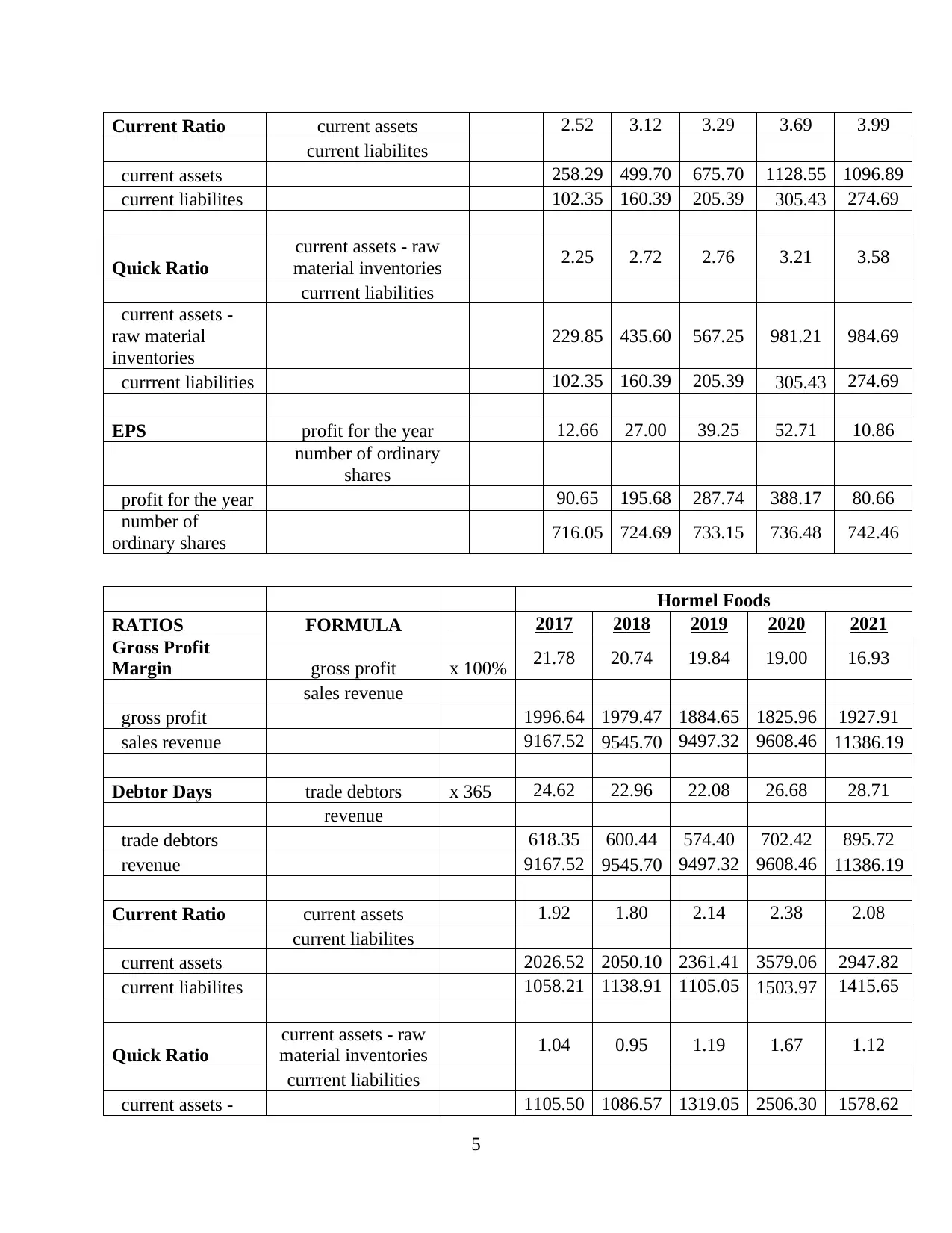
Current Ratio current assets 2.52 3.12 3.29 3.69 3.99
current liabilites
current assets 258.29 499.70 675.70 1128.55 1096.89
current liabilites 102.35 160.39 205.39 305.43 274.69
Quick Ratio
current assets - raw
material inventories 2.25 2.72 2.76 3.21 3.58
currrent liabilities
current assets -
raw material
inventories
229.85 435.60 567.25 981.21 984.69
currrent liabilities 102.35 160.39 205.39 305.43 274.69
EPS profit for the year 12.66 27.00 39.25 52.71 10.86
number of ordinary
shares
profit for the year 90.65 195.68 287.74 388.17 80.66
number of
ordinary shares 716.05 724.69 733.15 736.48 742.46
Hormel Foods
RATIOS FORMULA 2017 2018 2019 2020 2021
Gross Profit
Margin gross profit x 100% 21.78 20.74 19.84 19.00 16.93
sales revenue
gross profit 1996.64 1979.47 1884.65 1825.96 1927.91
sales revenue 9167.52 9545.70 9497.32 9608.46 11386.19
Debtor Days trade debtors x 365 24.62 22.96 22.08 26.68 28.71
revenue
trade debtors 618.35 600.44 574.40 702.42 895.72
revenue 9167.52 9545.70 9497.32 9608.46 11386.19
Current Ratio current assets 1.92 1.80 2.14 2.38 2.08
current liabilites
current assets 2026.52 2050.10 2361.41 3579.06 2947.82
current liabilites 1058.21 1138.91 1105.05 1503.97 1415.65
Quick Ratio
current assets - raw
material inventories 1.04 0.95 1.19 1.67 1.12
currrent liabilities
current assets - 1105.50 1086.57 1319.05 2506.30 1578.62
5
current liabilites
current assets 258.29 499.70 675.70 1128.55 1096.89
current liabilites 102.35 160.39 205.39 305.43 274.69
Quick Ratio
current assets - raw
material inventories 2.25 2.72 2.76 3.21 3.58
currrent liabilities
current assets -
raw material
inventories
229.85 435.60 567.25 981.21 984.69
currrent liabilities 102.35 160.39 205.39 305.43 274.69
EPS profit for the year 12.66 27.00 39.25 52.71 10.86
number of ordinary
shares
profit for the year 90.65 195.68 287.74 388.17 80.66
number of
ordinary shares 716.05 724.69 733.15 736.48 742.46
Hormel Foods
RATIOS FORMULA 2017 2018 2019 2020 2021
Gross Profit
Margin gross profit x 100% 21.78 20.74 19.84 19.00 16.93
sales revenue
gross profit 1996.64 1979.47 1884.65 1825.96 1927.91
sales revenue 9167.52 9545.70 9497.32 9608.46 11386.19
Debtor Days trade debtors x 365 24.62 22.96 22.08 26.68 28.71
revenue
trade debtors 618.35 600.44 574.40 702.42 895.72
revenue 9167.52 9545.70 9497.32 9608.46 11386.19
Current Ratio current assets 1.92 1.80 2.14 2.38 2.08
current liabilites
current assets 2026.52 2050.10 2361.41 3579.06 2947.82
current liabilites 1058.21 1138.91 1105.05 1503.97 1415.65
Quick Ratio
current assets - raw
material inventories 1.04 0.95 1.19 1.67 1.12
currrent liabilities
current assets - 1105.50 1086.57 1319.05 2506.30 1578.62
5
Secure Best Marks with AI Grader
Need help grading? Try our AI Grader for instant feedback on your assignments.
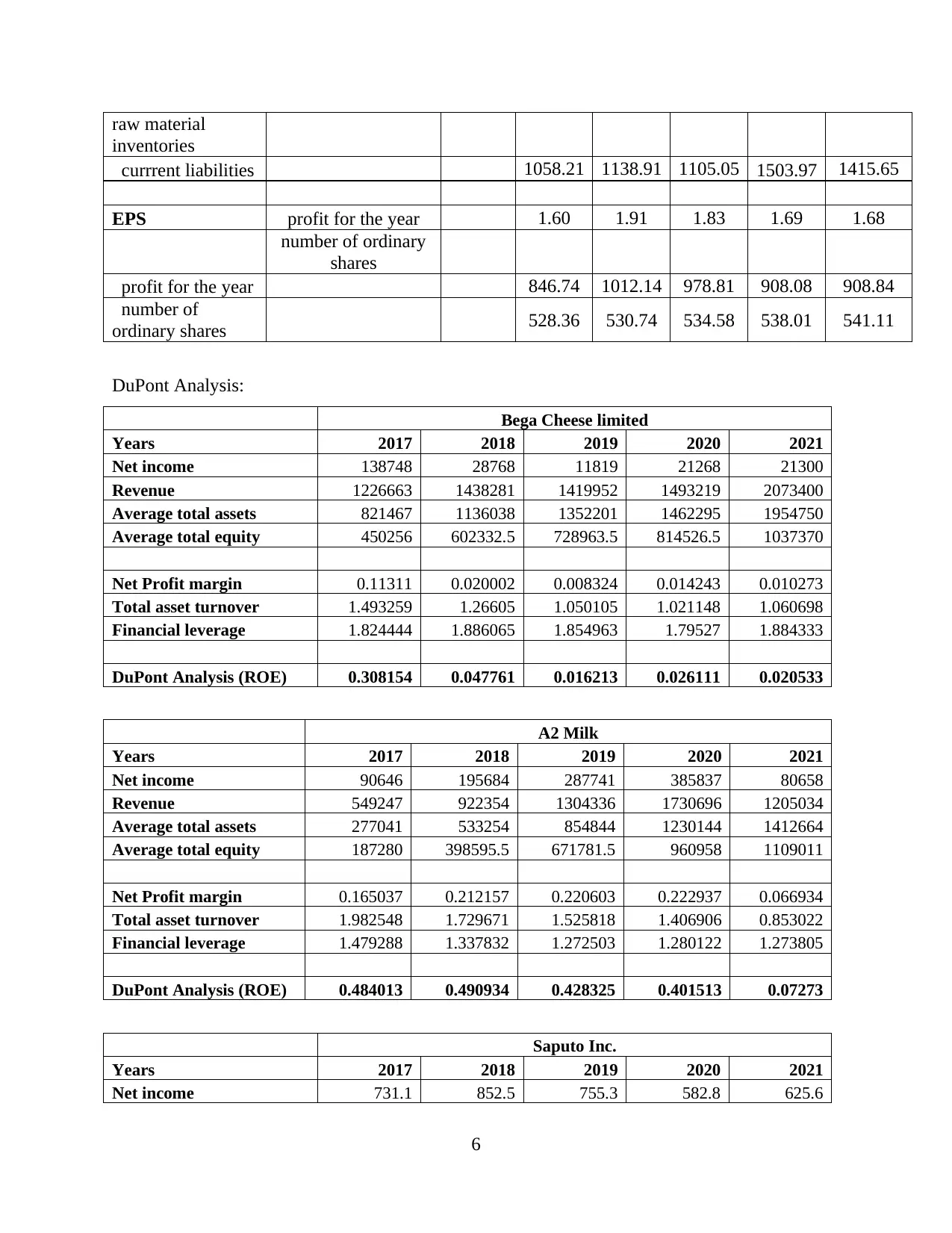
raw material
inventories
currrent liabilities 1058.21 1138.91 1105.05 1503.97 1415.65
EPS profit for the year 1.60 1.91 1.83 1.69 1.68
number of ordinary
shares
profit for the year 846.74 1012.14 978.81 908.08 908.84
number of
ordinary shares 528.36 530.74 534.58 538.01 541.11
DuPont Analysis:
Bega Cheese limited
Years 2017 2018 2019 2020 2021
Net income 138748 28768 11819 21268 21300
Revenue 1226663 1438281 1419952 1493219 2073400
Average total assets 821467 1136038 1352201 1462295 1954750
Average total equity 450256 602332.5 728963.5 814526.5 1037370
Net Profit margin 0.11311 0.020002 0.008324 0.014243 0.010273
Total asset turnover 1.493259 1.26605 1.050105 1.021148 1.060698
Financial leverage 1.824444 1.886065 1.854963 1.79527 1.884333
DuPont Analysis (ROE) 0.308154 0.047761 0.016213 0.026111 0.020533
A2 Milk
Years 2017 2018 2019 2020 2021
Net income 90646 195684 287741 385837 80658
Revenue 549247 922354 1304336 1730696 1205034
Average total assets 277041 533254 854844 1230144 1412664
Average total equity 187280 398595.5 671781.5 960958 1109011
Net Profit margin 0.165037 0.212157 0.220603 0.222937 0.066934
Total asset turnover 1.982548 1.729671 1.525818 1.406906 0.853022
Financial leverage 1.479288 1.337832 1.272503 1.280122 1.273805
DuPont Analysis (ROE) 0.484013 0.490934 0.428325 0.401513 0.07273
Saputo Inc.
Years 2017 2018 2019 2020 2021
Net income 731.1 852.5 755.3 582.8 625.6
6
inventories
currrent liabilities 1058.21 1138.91 1105.05 1503.97 1415.65
EPS profit for the year 1.60 1.91 1.83 1.69 1.68
number of ordinary
shares
profit for the year 846.74 1012.14 978.81 908.08 908.84
number of
ordinary shares 528.36 530.74 534.58 538.01 541.11
DuPont Analysis:
Bega Cheese limited
Years 2017 2018 2019 2020 2021
Net income 138748 28768 11819 21268 21300
Revenue 1226663 1438281 1419952 1493219 2073400
Average total assets 821467 1136038 1352201 1462295 1954750
Average total equity 450256 602332.5 728963.5 814526.5 1037370
Net Profit margin 0.11311 0.020002 0.008324 0.014243 0.010273
Total asset turnover 1.493259 1.26605 1.050105 1.021148 1.060698
Financial leverage 1.824444 1.886065 1.854963 1.79527 1.884333
DuPont Analysis (ROE) 0.308154 0.047761 0.016213 0.026111 0.020533
A2 Milk
Years 2017 2018 2019 2020 2021
Net income 90646 195684 287741 385837 80658
Revenue 549247 922354 1304336 1730696 1205034
Average total assets 277041 533254 854844 1230144 1412664
Average total equity 187280 398595.5 671781.5 960958 1109011
Net Profit margin 0.165037 0.212157 0.220603 0.222937 0.066934
Total asset turnover 1.982548 1.729671 1.525818 1.406906 0.853022
Financial leverage 1.479288 1.337832 1.272503 1.280122 1.273805
DuPont Analysis (ROE) 0.484013 0.490934 0.428325 0.401513 0.07273
Saputo Inc.
Years 2017 2018 2019 2020 2021
Net income 731.1 852.5 755.3 582.8 625.6
6
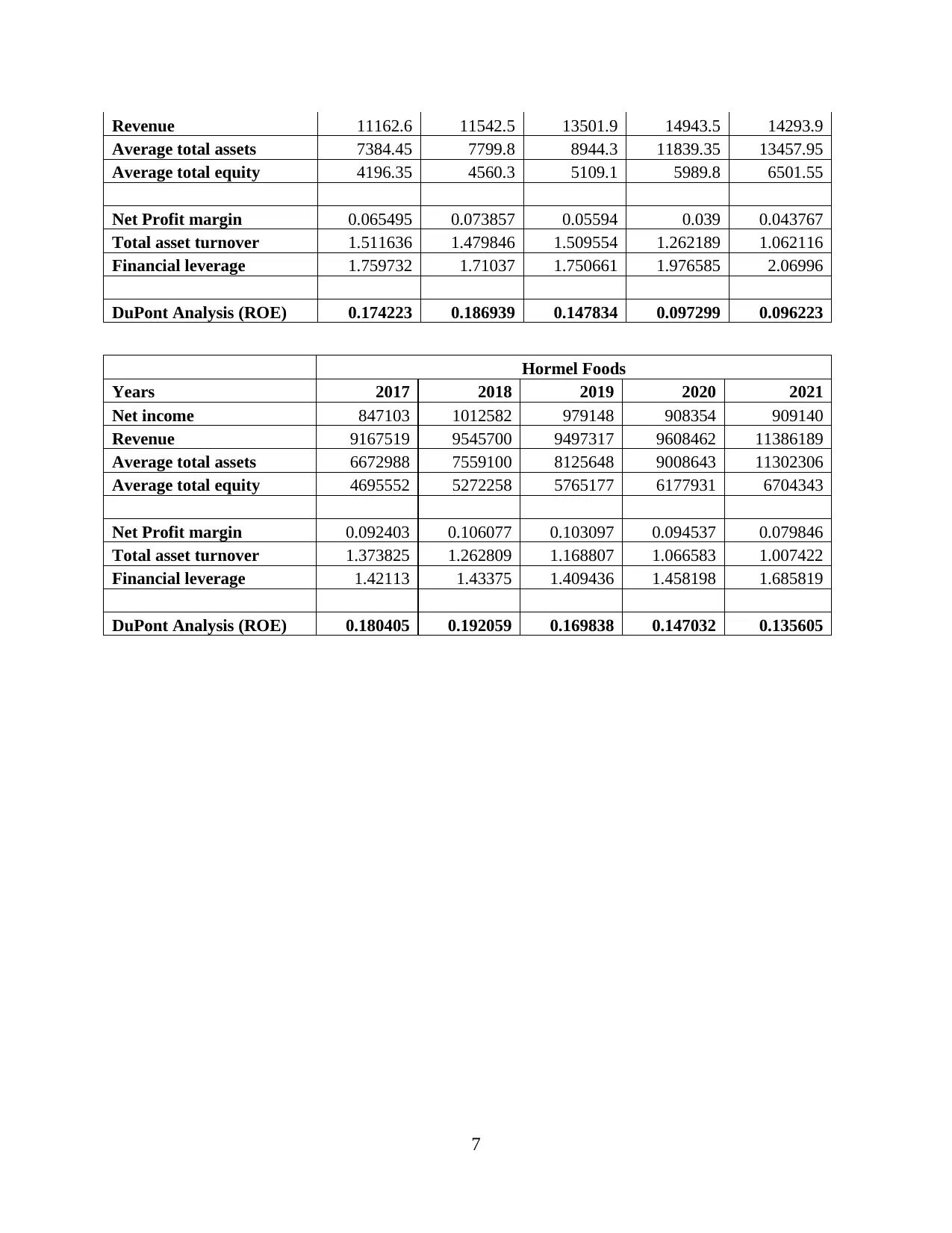
Revenue 11162.6 11542.5 13501.9 14943.5 14293.9
Average total assets 7384.45 7799.8 8944.3 11839.35 13457.95
Average total equity 4196.35 4560.3 5109.1 5989.8 6501.55
Net Profit margin 0.065495 0.073857 0.05594 0.039 0.043767
Total asset turnover 1.511636 1.479846 1.509554 1.262189 1.062116
Financial leverage 1.759732 1.71037 1.750661 1.976585 2.06996
DuPont Analysis (ROE) 0.174223 0.186939 0.147834 0.097299 0.096223
Hormel Foods
Years 2017 2018 2019 2020 2021
Net income 847103 1012582 979148 908354 909140
Revenue 9167519 9545700 9497317 9608462 11386189
Average total assets 6672988 7559100 8125648 9008643 11302306
Average total equity 4695552 5272258 5765177 6177931 6704343
Net Profit margin 0.092403 0.106077 0.103097 0.094537 0.079846
Total asset turnover 1.373825 1.262809 1.168807 1.066583 1.007422
Financial leverage 1.42113 1.43375 1.409436 1.458198 1.685819
DuPont Analysis (ROE) 0.180405 0.192059 0.169838 0.147032 0.135605
7
Average total assets 7384.45 7799.8 8944.3 11839.35 13457.95
Average total equity 4196.35 4560.3 5109.1 5989.8 6501.55
Net Profit margin 0.065495 0.073857 0.05594 0.039 0.043767
Total asset turnover 1.511636 1.479846 1.509554 1.262189 1.062116
Financial leverage 1.759732 1.71037 1.750661 1.976585 2.06996
DuPont Analysis (ROE) 0.174223 0.186939 0.147834 0.097299 0.096223
Hormel Foods
Years 2017 2018 2019 2020 2021
Net income 847103 1012582 979148 908354 909140
Revenue 9167519 9545700 9497317 9608462 11386189
Average total assets 6672988 7559100 8125648 9008643 11302306
Average total equity 4695552 5272258 5765177 6177931 6704343
Net Profit margin 0.092403 0.106077 0.103097 0.094537 0.079846
Total asset turnover 1.373825 1.262809 1.168807 1.066583 1.007422
Financial leverage 1.42113 1.43375 1.409436 1.458198 1.685819
DuPont Analysis (ROE) 0.180405 0.192059 0.169838 0.147032 0.135605
7
1 out of 24
Related Documents
Your All-in-One AI-Powered Toolkit for Academic Success.
+13062052269
info@desklib.com
Available 24*7 on WhatsApp / Email
![[object Object]](/_next/static/media/star-bottom.7253800d.svg)
Unlock your academic potential
© 2024 | Zucol Services PVT LTD | All rights reserved.



